Palm JIMI Cellphone with Bluetooth User Manual Palm Treo 700w smartphone Quick Reference Guide
Palm Inc Cellphone with Bluetooth Palm Treo 700w smartphone Quick Reference Guide
Palm >
Contents
- 1. Users Manual
- 2. QPU User manual
Users Manual

CONTENTS
i
Learning the basics . . . . . . . . . . . . . . . . . . . . . . . . . . . 1
Palm® Treo™ 700w smartphone overview . . . . . . . . . . . . . . . . . . . . .1
Turning your smartphone on/off . . . . . . . . . . . . . . . . . . . . . . . . . . . . . 3
Moving around the screen . . . . . . . . . . . . . . . . . . . . . . . . . . . . . . . . . 4
Using the keyboard . . . . . . . . . . . . . . . . . . . . . . . . . . . . . . . . . . . . . . 10
Opening and closing applications . . . . . . . . . . . . . . . . . . . . . . . . . . . 14
Using your Today screen . . . . . . . . . . . . . . . . . . . . . . . . . . . . . . . . . 15
Synchronizing contacts and other info . . . . . . . . . . . . . . . . . . . . . . . 16
Maximizing battery life . . . . . . . . . . . . . . . . . . . . . . . . . . . . . . . . . . . 17
Using your phone . . . . . . . . . . . . . . . . . . . . . . . . . . . . 19
Phone overview . . . . . . . . . . . . . . . . . . . . . . . . . . . . . . . . . . . . . . . . 19
Making calls . . . . . . . . . . . . . . . . . . . . . . . . . . . . . . . . . . . . . . . . . . . 22
Receiving calls . . . . . . . . . . . . . . . . . . . . . . . . . . . . . . . . . . . . . . . . . 26
Using voicemail . . . . . . . . . . . . . . . . . . . . . . . . . . . . . . . . . . . . . . . . 27
Managing active calls . . . . . . . . . . . . . . . . . . . . . . . . . . . . . . . . . . . . 28
Creating a speed dial button . . . . . . . . . . . . . . . . . . . . . . . . . . . . . . . 32
Using a phone headset . . . . . . . . . . . . . . . . . . . . . . . . . . . . . . . . . . . 34
Staying organized . . . . . . . . . . . . . . . . . . . . . . . . . . . 36
Contacts . . . . . . . . . . . . . . . . . . . . . . . . . . . . . . . . . . . . . . . . . . . . . . 36
Calendar . . . . . . . . . . . . . . . . . . . . . . . . . . . . . . . . . . . . . . . . . . . . . . 37
Staying in touch . . . . . . . . . . . . . . . . . . . . . . . . . . . . . 40
Messaging . . . . . . . . . . . . . . . . . . . . . . . . . . . . . . . . . . . . . . . . . . . . 40
Browsing the web . . . . . . . . . . . . . . . . . . . . . . . . . . . . . . . . . . . . . . . 54
Setting up a Bluetooth® connection . . . . . . . . . . . . . . . . . . . . . . . . . 56

ii
Playing media files . . . . . . . . . . . . . . . . . . . . . . . . . . 60
Pictures & Videos . . . . . . . . . . . . . . . . . . . . . . . . . . . . . . . . . . . . . . . 60
Windows Media Player Mobile . . . . . . . . . . . . . . . . . . . . . . . . . . . . . 63
Staying productive . . . . . . . . . . . . . . . . . . . . . . . . . . . 66
Word Mobile . . . . . . . . . . . . . . . . . . . . . . . . . . . . . . . . . . . . . . . . . . . 66
PowerPoint Mobile . . . . . . . . . . . . . . . . . . . . . . . . . . . . . . . . . . . . . . 67
Excel Mobile . . . . . . . . . . . . . . . . . . . . . . . . . . . . . . . . . . . . . . . . . . . 68
Managing files and applications . . . . . . . . . . . . . . . . . . 70
Finding information . . . . . . . . . . . . . . . . . . . . . . . . . . . . . . . . . . . . . . 70
Installing applications . . . . . . . . . . . . . . . . . . . . . . . . . . . . . . . . . . . . 72
Setting synchronization options . . . . . . . . . . . . . . . . . . . . . . . . . . . . 73
Using expansion cards . . . . . . . . . . . . . . . . . . . . . . . . . . . . . . . . . . . 76
Customizing your smartphone . . . . . . . . . . . . . . . . . . . 78
Today screen settings . . . . . . . . . . . . . . . . . . . . . . . . . . . . . . . . . . . . 78
Sound settings . . . . . . . . . . . . . . . . . . . . . . . . . . . . . . . . . . . . . . . . . 79
Display and appearance settings . . . . . . . . . . . . . . . . . . . . . . . . . . . . 82
Application settings . . . . . . . . . . . . . . . . . . . . . . . . . . . . . . . . . . . . . 83
Locking your smartphone and info . . . . . . . . . . . . . . . . . . . . . . . . . . 84
System settings . . . . . . . . . . . . . . . . . . . . . . . . . . . . . . . . . . . . . . . . 86
Getting help . . . . . . . . . . . . . . . . . . . . . . . . . . . . . . . 87
Performing a soft reset . . . . . . . . . . . . . . . . . . . . . . . . . . . . . . . . . . . 87
Where to learn more . . . . . . . . . . . . . . . . . . . . . . . . . . . . . . . . . . . . . 88
Regulatory Information . . . . . . . . . . . . . . . . . . . . . . . . 91
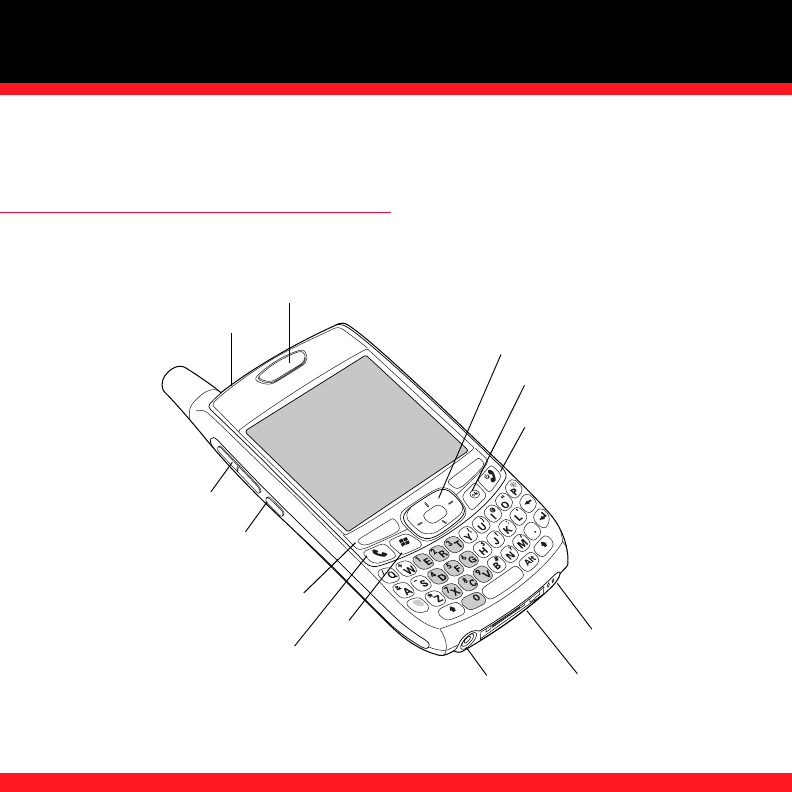
LEARNING THE BASICS
1
LEARNING THE BASICS
PALM® TREO™ 700W SMARTPHONE OVERVIEW
The following illustrations show the locations and names of the physical features of your
Palm® Treo™ 700w smartphone. Refer to these illustrations while following this guide.
Indicator light (phone
and charge indicator)
Multi-
connector
5-way navigator
Earpiece
Power/End button
Microphone
Headset
jack
Start
button
Phone/Send
button
Side button
OK button
Volume button
Action keys
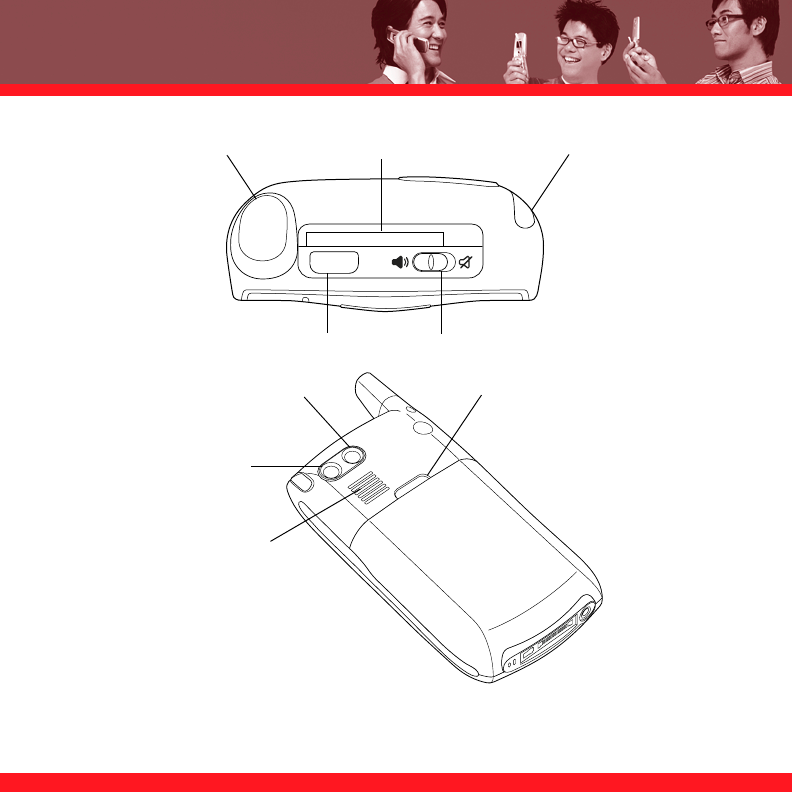
2
Ringer switch
Antenna
Infrared (IR) port
Stylus
Expansion card slot
Camera lens
(camera smart-
phone only)
Battery door release
Speaker
Self-portrait mirror

LEARNING THE BASICS
3
TURNING YOUR SMARTPHONE ON/OFF
You can use the organizer features of your Treo 700w smartphone independently of the wireless
features and applications. In other words, the screen and phone are designed to be turned off and
on separately.
NOTE To conserve battery power, the screen turns off automatically after one minute. If you want the screen to stay on
longer, you can adjust the shutoff setting. Press Start, select Settings, select the System tab, and then select Power. Select
the Advanced tab, and then increase the On battery power setting.
Turning your phone on and off
When you turn on your phone, it connects to a mobile network so that you can make and receive
phone calls and use other wireless services.
1. Press and hold Power/End to turn on your phone. When your smartphone locates a
signal, Verizon Wireless and the signal-strength icon appear at the top of the screen and
the indicator light flashes green, indicating you can use the phone and Internet features (if
supported by the local network). If you’re outside a coverage area, the indicator light flashes
amber and no bars appear in the signal-strength icon.
2. Press and hold Power/End again to turn off your phone. When your phone is off, the
phone-off icon appears at the top of the screen and your smartphone is not connected to
any mobile network. You can still use the organizer and other features.
Waking up the screen
To use the organizer features when your smartphone’s screen is off, you need to wake up the
screen. You can also turn off your smartphone’s screen without turning off your smartphone’s
wireless features.
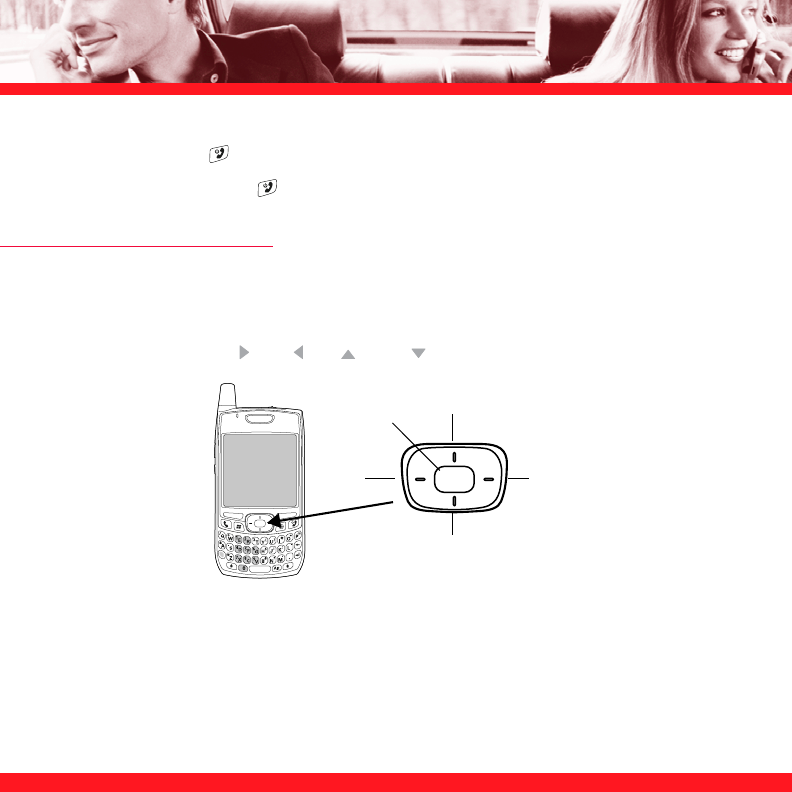
4
1. Press Power/End to wake up the screen.
2. Briefly press Power/End to turn off the screen.
MOVING AROUND THE SCREEN
To move around the Treo 700w smartphone screen, you can use the 5-way navigator or you can
tap items on the screen with the stylus. As you become familiar with your smartphone, you’ll find
your own favorite way to scroll, highlight, and select items.
The 5-way includes Right , Left , Up , Down , and Center buttons.
Scrolling through screens
As on a computer, on your smartphone you scroll to move from field to field or page to page,
or in some cases to highlight an item or option in a list.
Up
Right
Left
Down
Center
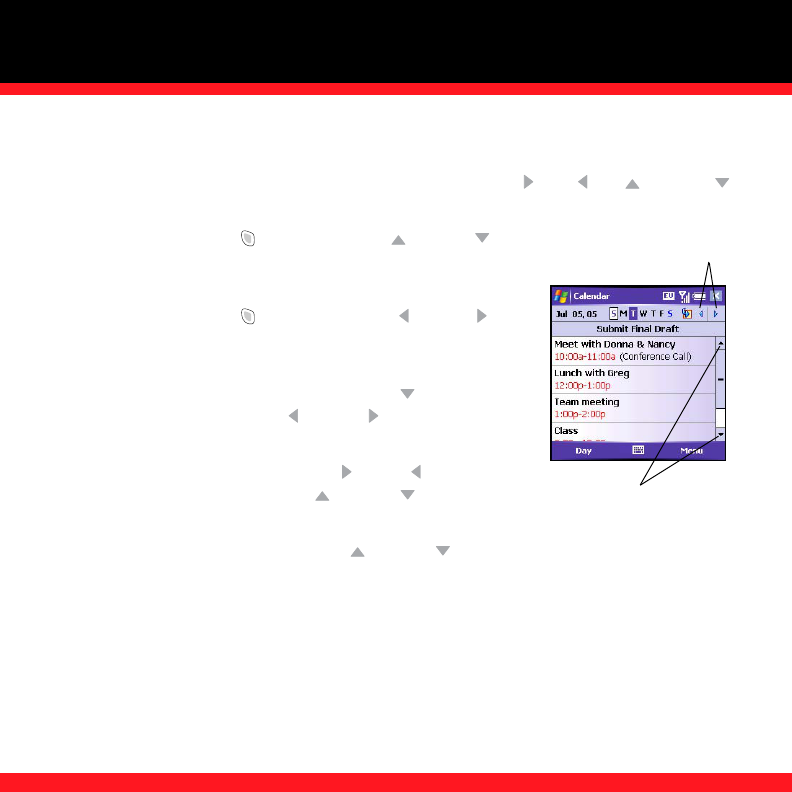
LEARNING THE BASICS
5
There are several methods of scrolling:
■Press the 5-way on the front of your smartphone. Press Right , Left , Up , or Down
to move to the next field, button, or action in that direction.
■Press and hold Option while pressing Up or Down to
scroll one screen at a time. These keys work just like the
Page Up and Page Down keys on your computer keyboard.
■Press and hold Option while pressing Left or Right to
jump to the top or bottom of the current document or entry.
■When viewing a screen with tabs, such as when adding a
contact or customizing settings, press Down to scroll to
the tabs, and then press Left or Right to move between
tabs.
■When inside a text field, press Right or Left to move to
the next character, and press Up or Down to move
between lines.
■When inside a list, press and hold Up or Down to rapidly scroll through the list.
■Tap an onscreen scroll arrow.
■Tap and drag the slider of an onscreen scroll bar.
Scroll arrows
Scroll arrows
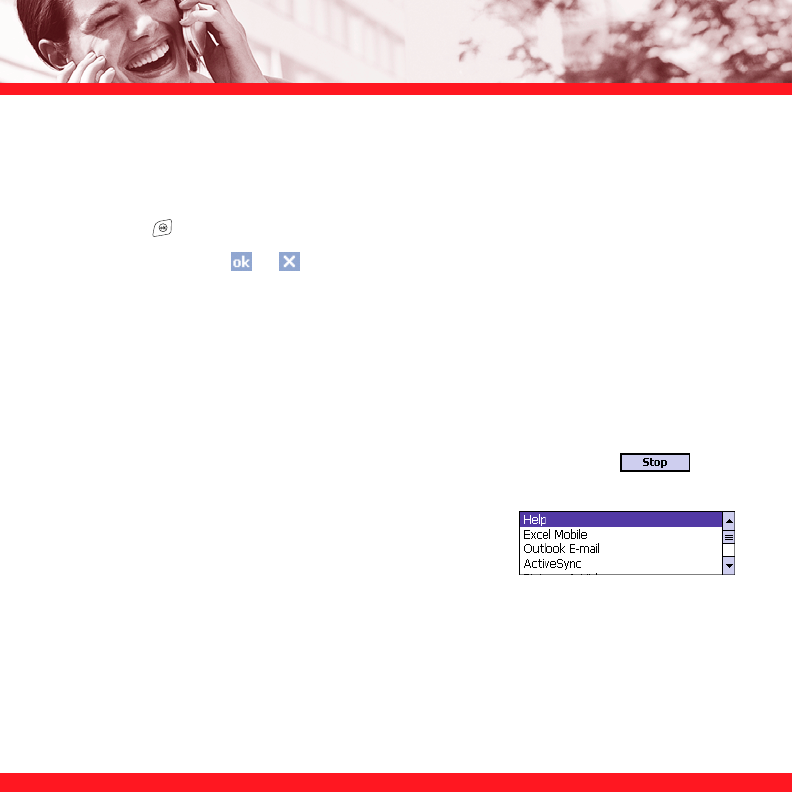
6
Closing screens
To accept the information you entered on a screen and to return to the previous screen, do one of
the following:
■Press OK .
■Use the stylus to tap or in the upper-right corner of the screen.
Highlighting and selecting items
On most screens, one item—a button, a list entry, or a check box—is highlighted by default. The
highlight identifies which item is affected by your next action. Use the 5-way to move the
highlight from one item to another before opening or selecting it.
The highlight can take one of two forms, depending on what is highlighted:
■Border glow: This rectangular border highlights items such as an
onscreen button (for example OK, Dismiss, or Hide), a check box,
an option, or a web link.
■Reverse type (light text on a dark background): This
highlights items such as a phone number, an email address,
text, or an item in a list.
After highlighting an item with the 5-way, you can select or
activate it by pressing Center or by tapping the item with the stylus.
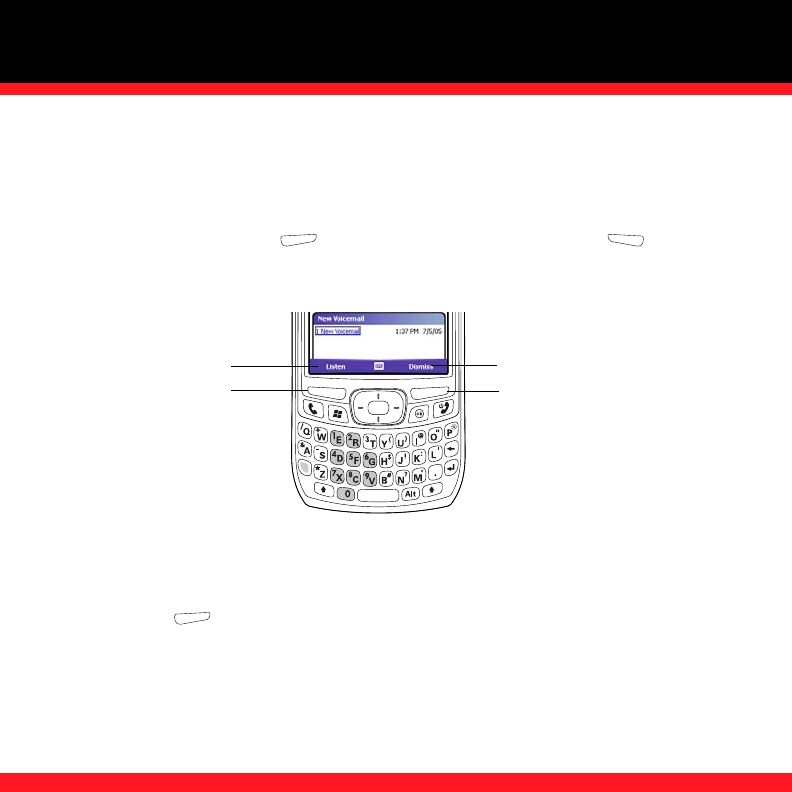
LEARNING THE BASICS
7
Using the action keys
The action keys are designed to give you quick access to relevant tasks, so the action key items
vary from application to application, and from screen to screen, and in some cases may not be
available at all. Action keys activate the items that appear directly above them on the screen. In
most cases the right action key opens the menu, and the left action key activates a
specific command, such as New or Edit. Remember that action key functions vary from screen to
screen, so be sure to check the onscreen label before pressing the action keys.
Selecting menu items
In many applications, a menu provides access to additional features. The menu is hidden until
you press Menu . To get the most out of your smartphone, it’s a good idea to familiarize
yourself with the additional features available through the menu in various applications.
Left action key Right action key
Left action key activates
this command
Right action key activates
this command
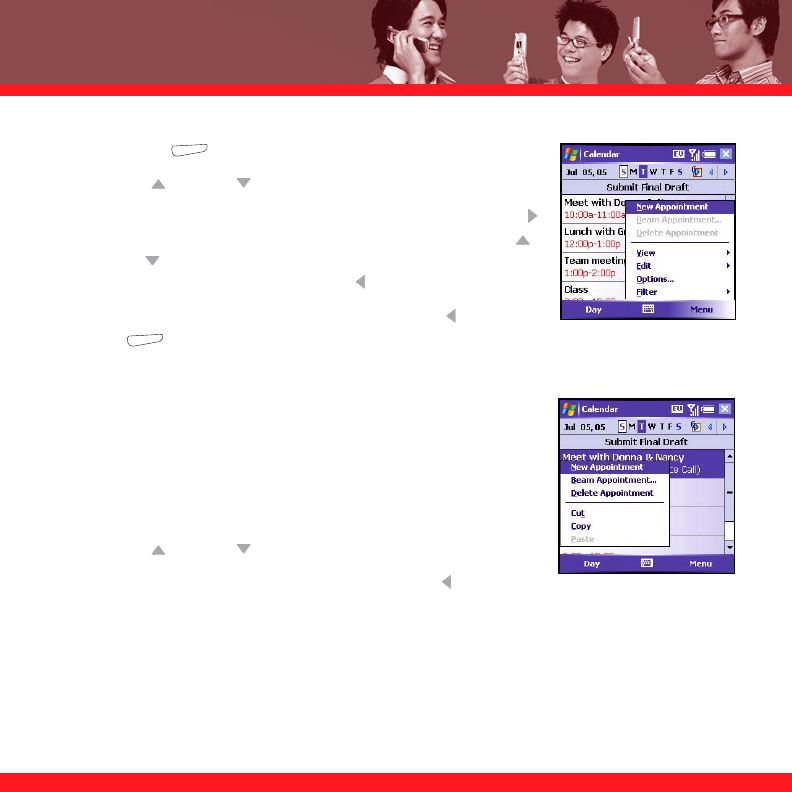
8
1. Press Menu to display an application’s menu.
2. Press Up or Down to highlight a menu item.
3. If an arrow appears next to a menu item, press Center or Right
to display additional options for that item, and then press Up
or Down to highlight a menu item. To return to the main menu
without making a selection, press Left .
4. Press Center to select the menu item, or press Left or
Menu to close the menu and cancel your selection.
Selecting options in a shortcut menu
Most applications also provide access to context-sensitive, shortcut
menus—similar to the right-click menus on a computer. The
shortcut menu options vary based on the highlighted selection.
1. Highlight the item you want to open the shortcut menu for.
2. Press and hold Center to open the shortcut menu.
3. Press Up or Down to highlight a menu item.
4. Press Center to select the menu item or press Left to cancel
your selection.
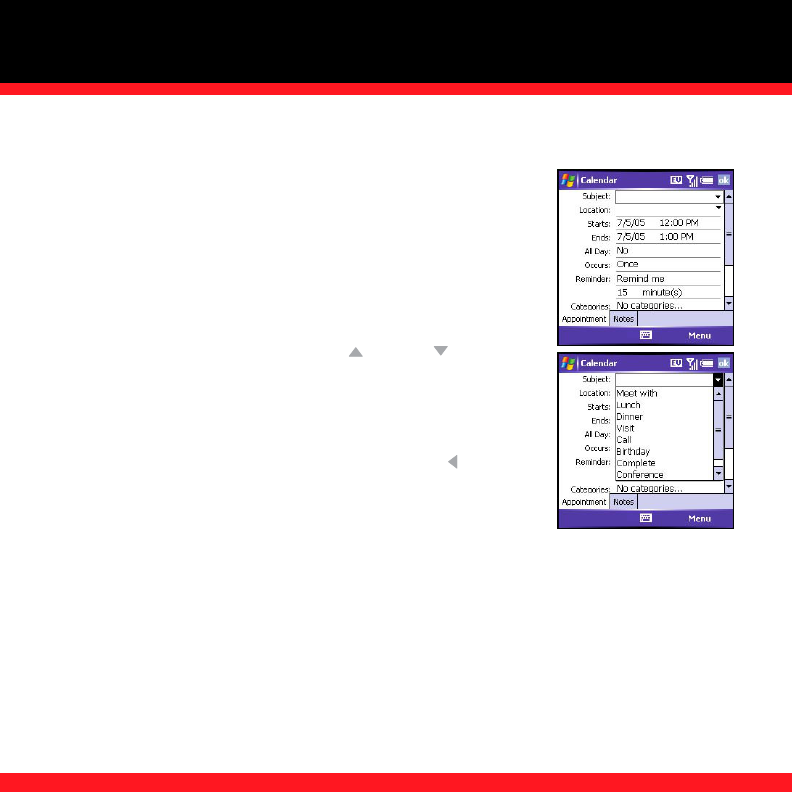
LEARNING THE BASICS
9
Selecting options in a list
Lists let you select from a range of options. You can identify whether
a list is available when you select the field. If a rectangle appears
around the field along with a downward-pointing arrow, a list is
available. Lists are different from the menus described earlier in this
section.
To select from a list, do any of the following:
■Use the 5-way to highlight the field, and then press Center to
display the items in the list. Press Up or Down to highlight
the item you want, and then press Center to accept your
selection.
■Use your stylus to tap the arrow, and then tap the item in the list.
■To exit the list and cancel your selection, press Left .
NOTE When selecting fields you might not see the downward-pointing arrow until you
press Center. In fields where you see a downward-pointing arrow but no rectangle, you
must tap the arrow with the stylus to expand the field.

10
USING THE KEYBOARD
When using the keyboard, most people find it easiest to hold the smartphone with two hands and
to use the tips of both thumbs to press the keys.
Understanding the keyboard backlight
Your smartphone includes a keyboard backlight for low light conditions. The keyboard backlight
activates automatically when the screen turns on. It turns off automatically when the screen turns
off or when you are on a call or playing music in the background for longer than the time
specified in Backlight Settings. The backlight also turns off when an application’s power-saving
features turn it off.
Action key Action key
Phone/Send
Start
Power/End
OK
Backspace
Option
Shift
Space
Return
Shift
Alt
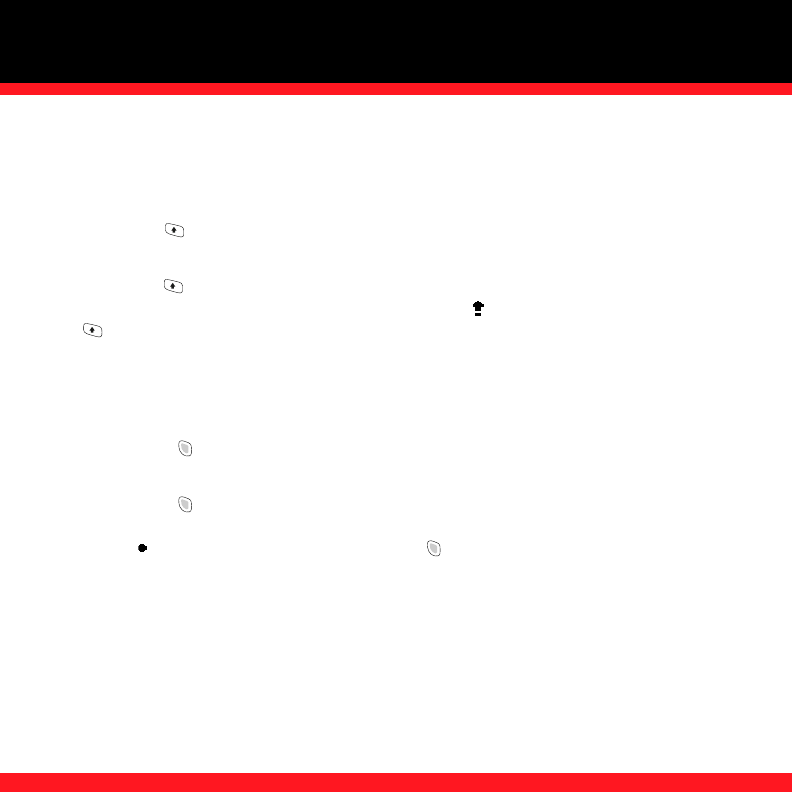
LEARNING THE BASICS
11
Entering lowercase and uppercase letters
By default, the first letter of each sentence or field is capitalized and the remaining text you enter
is lowercase. To enter other uppercase letters, do one of the following:
■Press Shift , and then enter a letter. You don’t need to press and hold Shift while entering
a letter.
■Press Shift twice to turn on Caps Lock, and then enter a series of letters. When Caps Lock
is on, this symbol appears at the bottom of the screen: . To turn off Caps Lock, press Shift
again.
Entering numbers, punctuation, and symbols
Numbers, punctuation, and symbols appear above the letters on the keys. To enter these
characters, do one of the following:
■Press Option , and then press the key of the desired character. You don’t need to hold
Option while pressing the key.
■Press Option twice to turn on Option Lock, and then press the desired keys to enter a
series of characters. When Option Lock is on, this symbol appears at the bottom of the
screen: . To turn off Option Lock, press Option again.

12
Entering other symbols and accented characters
You can enter symbols and accented characters that don't appear on the keys using the alternate
characters list. The alternate characters are grouped according to their similarity to the
corresponding key. For example, the alternate characters available for the e key are é, è, ë, and ê.
If you press the wrong key, press Backspace to return to the full list of alternate characters. You
can then press another key.
1. Press Alt to display the alternate character list.
2. Narrow the list by pressing the key that corresponds to the character you want. For example,
to enter an é, press e. See the table on the next page for a list of corresponding characters.
3. Press Up or Down to highlight the desired character.
4. Press Center to insert the character.
NOTE If you don’t know which key to press to narrow the list in step 2, you can scroll through the list until you find the
character you want.
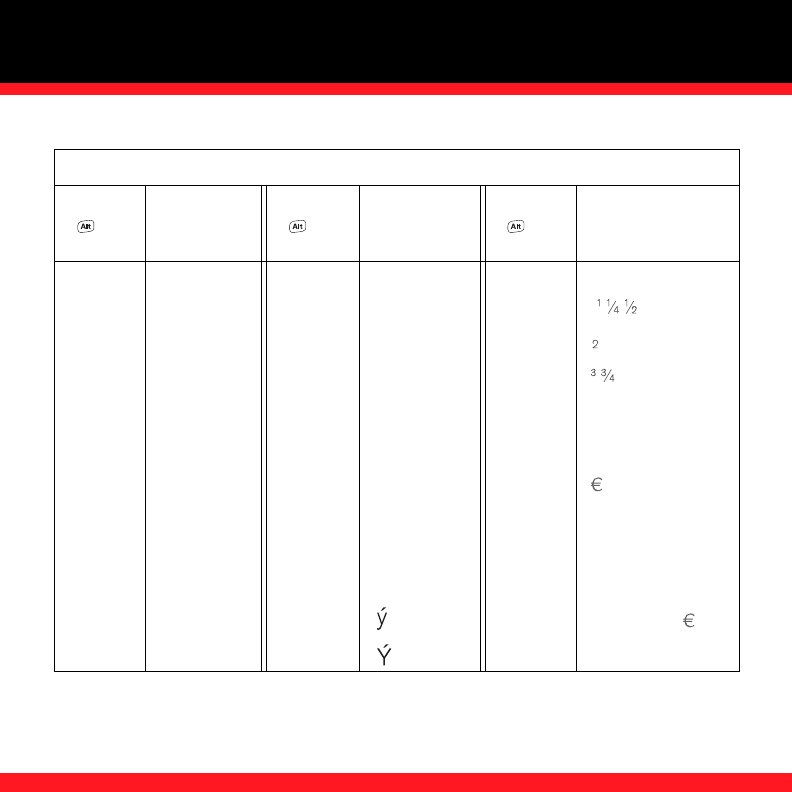
LEARNING THE BASICS
13
Symbols and accented characters
Press Alt
and
enter...
to select... Press Alt
and
enter...
to select... Press Alt
and
enter...
to select...
a á à ä â ã å æ o ó ò ö ô œ õ 0 °
A Á À Ä Â Ã Å Æ O Ó Ò Ö Ô Œ Õ 1
b or B ß p or P ¶ 2
c ç ¢ © r or R ® 3
C Ç ¢ © s ß Šs §
e é è ë ê S ß ŠS §
E É È Ë Ê t or T ™ $ £ ¥ ¢
i í ì ï î u ú ù ü û ! ¡
I Í Ì Ï Î U Ú Ù Ü Û ? ¿
l or L £ x or X x ¤ ; :-) :-( ;-)
n ñ y ÿ . , ' " @ + -
* / # ( or ) : & _ • % = ÷ ^ £ ¥
¢ [ ] { } < > « » © ® °
~ \ Ø µ |
NÑ Y
Ÿ
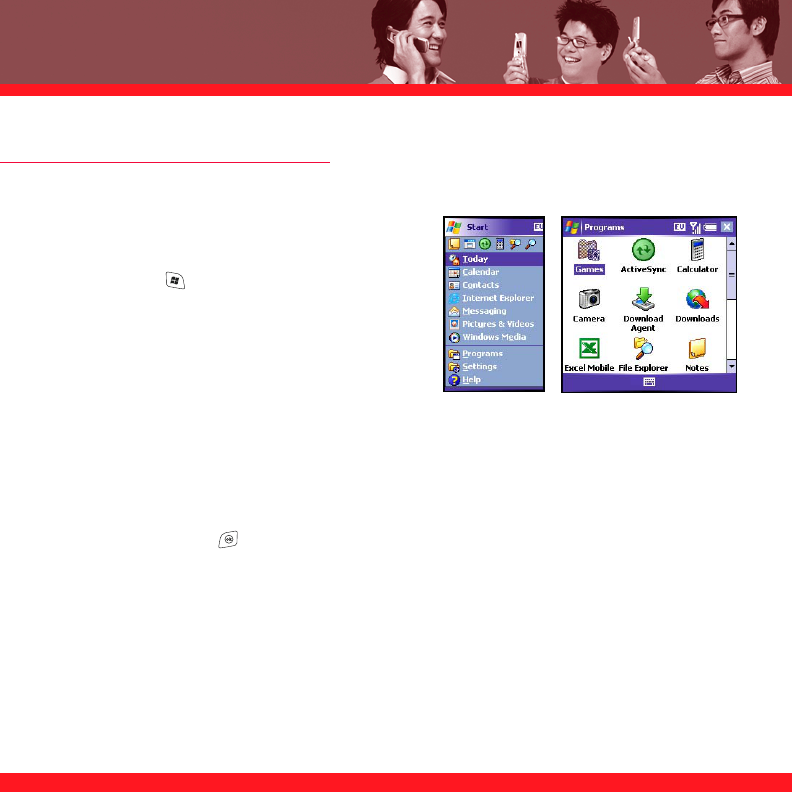
14
OPENING AND CLOSING APPLICATIONS
Opening applications
You can access all the applications on your
smartphone through the Start menu:
1. Press Start to open the Start menu.
2. Use the 5-way navigator to highlight the
application you want to use. To view additional
applications, select Programs.
3. Press Center to open the selected application.
Closing applications
You can have several applications open at once, so you don’t need to exit an application to open
another one. In most cases, applications close automatically when available memory is low, but
you can also close applications manually.
1. Press and hold OK to open the Memory Settings screen.
2. On the Running Programs tab, do one of the following:
■Select the application you want to close, and then select Stop to close it.
■Select Stop All to close all of your open applications.
NOTE You can also open the Memory Settings screen by pressing Option + OK, or by pressing Start, selecting Settings,
selecting the System tab, and then selecting Memory.
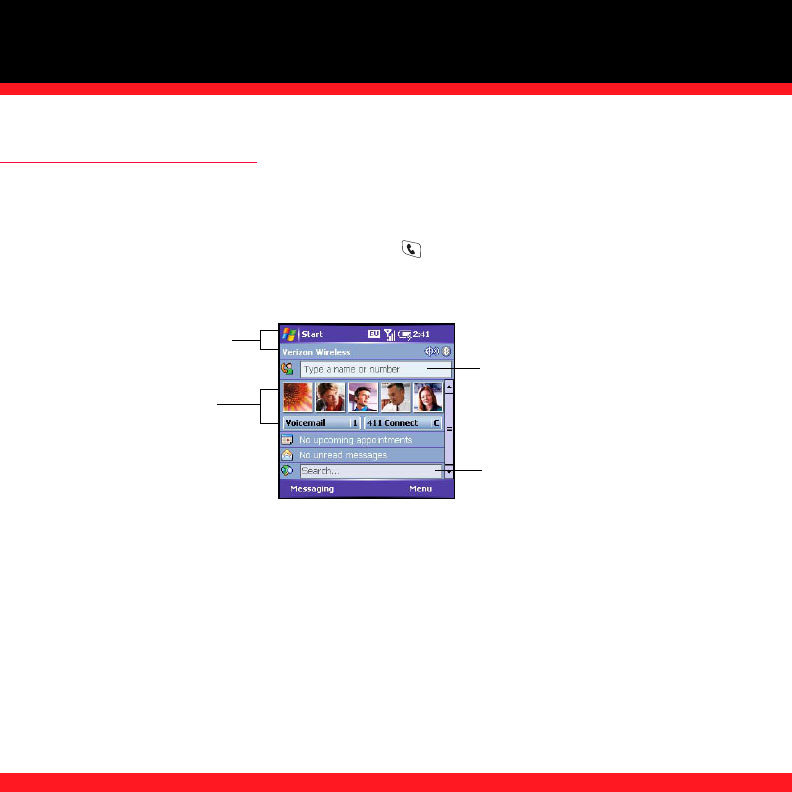
LEARNING THE BASICS
15
USING YOUR TODAY SCREEN
Your Today screen is your home base where you can quickly look up contacts, dial numbers, see
appointments and the number of unread email messages, and even display a web page.
To access your Today screen, press Phone/Send .
NOTE Pressing Phone/Send while a phone number is highlighted dials the number. To access your Today screen when a
phone number is highlighted, deselect the number and press Phone/Send, or press Start and select Today.
■Title bar and status info: See “Phone overview” on page 19 to learn about the icons that
appear in this area.
■Dial Lookup field: Begin typing the name or number you want to look up. See “Dialing by
contact name” on page 23 for more info.
■Web Search field: Enter a word you want to find on the Internet and press Center to begin the
search (data services connection required).
■Speed dial buttons: Select the picture or button you want to dial. See “Creating a speed dial
button” on page 32 to create your own.
Title bar and
status info Dial Lookup field
Web Search field
Speed dial
buttons
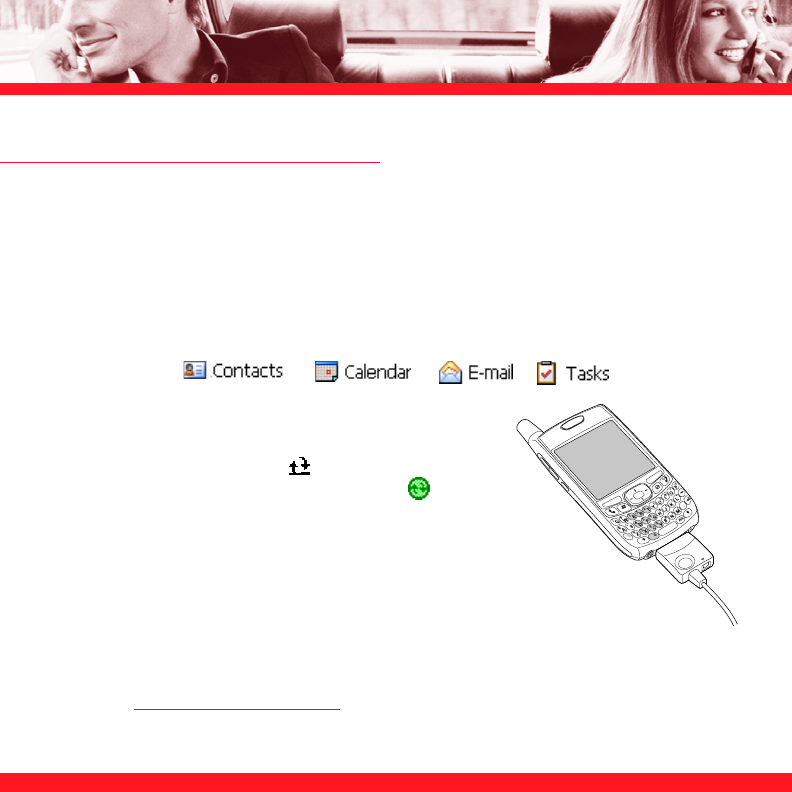
16
SYNCHRONIZING CONTACTS AND OTHER INFO
To synchronize your contacts and other personal information, you must first install the software
from the CD that came with your smartphone and set up a connection between your computer
and your smartphone. See the setup poster for instructions.
After you complete the setup process, each time you connect your smartphone to your computer
it automatically synchronizes the items that are set to sync. You can customize the sync settings
(see “Setting synchronization options” on page 73) or use the default settings to synchronize
your info from the following applications:
1. Connect your smartphone to your computer. You should
hear the ActiveSync® tone.
2. Look for the ActiveSync icon at the top of your
smartphone’s screen and the ActiveSync icon in the
taskbar on your computer.
■If you don’t see the ActiveSync icon, make sure the
desktop synchronization software that came with your
smartphone is running on your computer.
■If you have any problems synchronizing, see the
electronic User Guide for troubleshooting suggestions.
NOTE We recommend installing a backup program to preserve your data and settings if your smartphone is ever lost or
stolen. A backup and restore program also protects your data during a hard reset. To download a free backup and restore
program, visit www.palm.com/mytreo700wVerizon.

LEARNING THE BASICS
17
MAXIMIZING BATTERY LIFE
Battery life depends on individual usage. When used as a smartphone, your smartphone battery
provides up to 4.5 hours of talk time or up to 15 days of standby time.
You can increase your smartphone’s battery life by following a few easy guidelines. Remember
that battery life depends on how you use your smartphone.
■Charge your smartphone whenever you’re at your desk, or charge it overnight each day. The
battery in your smartphone has a much longer useful life when it is topped off frequently,
versus charging it after it is fully drained.
■Your smartphone’s wireless features (phone, email, messaging, and web) generally consume
more power than the organizer features.
■If you spend a lot of time using the camera (if included), games, media players, eBooks, or
other applications, keep an eye on the battery icon and charge when necessary.
■If you don’t plan to use the wireless features on your smartphone for a while, put it into Flight
mode. You can forward calls to a different number or let all calls be picked up by voicemail
(see the electronic User Guide for details). To see if your smartphone is in Flight Mode, tap
the phone-off icon .
■As with any mobile phone, if you are in an area with no wireless coverage, your smartphone
searches for a signal, which consumes power. If you cannot move to an area of better
coverage, temporarily turn off your phone (see “Turning your phone on and off” on page 3).
■Turn off your smartphone’s Bluetooth® wireless technology feature when you do not need to
make a Bluetooth connection.

18
■Turn down the screen brightness (see “Adjusting the brightness” on page 82).
■Set your screen to turn off automatically after a shorter period of inactivity (see the User
Guide for details).
■Keep your battery away from direct sunlight and other sources of heat. Temperatures over
120 degrees Farenheit (50 degrees Celsius) can permanently reduce the capacity and life
span of any lithium ion battery.
NOTE If the battery is fully drained, it may take a few moments for the indicator light to turn on while charging. Don’t worry;
your smartphone stores your info safely until you recharge the battery. To avoid draining the battery, charge and synchronize
every day, especially if you use your smartphone often.
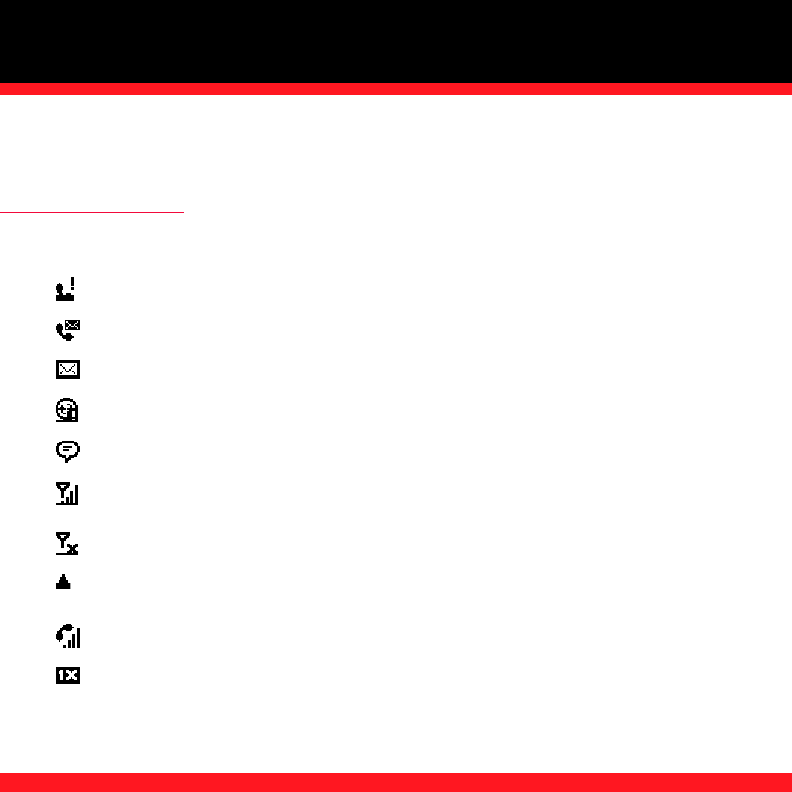
USING YOUR PHONE
19
USING YOUR PHONE
PHONE OVERVIEW
You can monitor the status of several items using icons at the top of your Today screen:
0
You missed an incoming call.
You have a voicemail message.
You have a new email, text, or multimedia message.
An error occurred during synchronization.
You have more than one of the conditions listed above.
Your phone is on. The bars display the signal strength. The stronger the signal, the
more bars that appear. If you are outside a coverage area, no bars appear.
Your phone is off.
You are outside a Verizon Wireless coverage area and roaming on another mobile
service provider’s network. Data services may not be available when roaming.
A voice call is in progress.
You are in an area that supports NationalAccess (1xRTT) data services with average
speeds of 60–80Kbps and bursts up to 144Kbps.

20
You are in an area that supports BroadbandAccess (EVDO) data services with
average download speeds of 400–700Kbps, capable of reaching speeds up
to1.8Mbps, and upload speeds up to 156Kbps.
A NationalAccess data call is in progress. You can make calls but you cannot
receive calls—any incoming calls go to voicemail. When you make a call the data
transmission is automatically interrupted.
A BroadbandAccess data call is in progress. You can still make or receive calls.
When you make or receive a call, the data transmission is automatically interrupted.
Your phone is connected to a NationalAccess network, but you are not actively
transmitting data. You can still make or receive calls.
Your phone is connected to a BroadbandAccess network, but you are not actively
transmitting data. You can still make or receive calls.
Your Palm® Treo™ 700w smartphone is connected to a computer or network that is
providing a data connection.
A data connection is not available or your phone is off.
Your smartphone’s battery is low.
Your smartphone’s battery is charging.
Your smartphone is connected to a power outlet and the battery is fully charged.
Network
name
Your phone is on and you are in a Verizon Wireless coverage area. If you are
outside a coverage area, No service or Roaming appears instead. When you turn off
your phone, Phone Off appears instead.
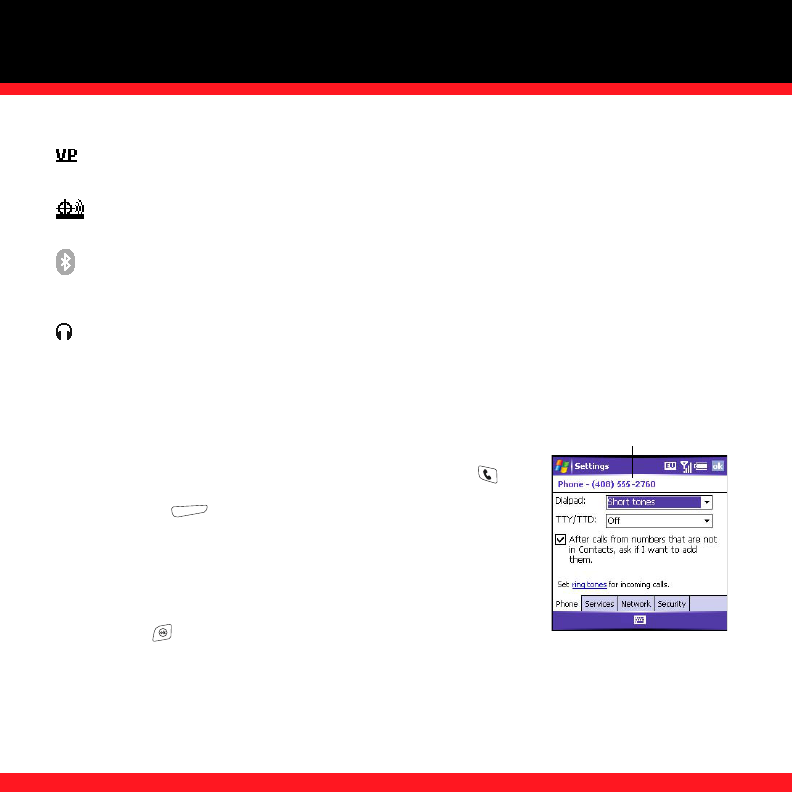
USING YOUR PHONE
21
What’s my number?
1. Make sure your phone is on (see “Turning your smartphone on/
off” on page 3).
2. If you do not see your Today screen, press Phone/Send .
3. Press Menu .
4. Select Preferences > Phone Settings.
5. On the Phone tab, look for your phone number below the title
bar.
6. Press OK .
NOTE If your phone number doesn’t appear on the Phone Settings screen, press OK, and then turn your phone off and back
on again. Repeat steps 1–6. If your phone number still doesn’t appear, your phone has not been activated. Turn your phone
off, wait a few hours, and then turn on your phone and repeat these steps. If your phone number still does not appear, please
contact Verizon Wireless for assistance.
Voice privacy is preventing over-the-air eavesdropping. Appears during a call when
this option is turned on and is available on the Verizon Wireless network.
Location privacy is off and your location is available to the Verizon Wireless
network and other applications.
The Bluetooth® wireless technology status indicator appears in gray when this
feature is off, in blue when this feature is on, and in reverse blue when your
smartphone is communicating with another Bluetooth device.
A call is in progress and your smartphone is connected to a Bluetooth headset or
car kit.
Look here for your
phone number
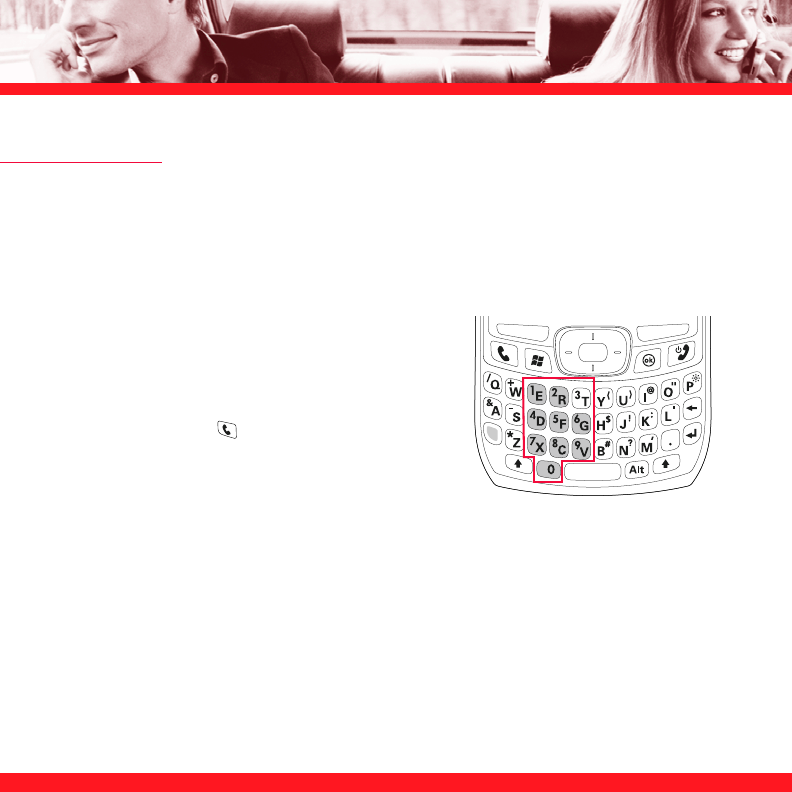
22
MAKING CALLS
Your smartphone offers several ways to make phone calls. Try them all and you’ll discover which
methods you prefer.
NOTE Be sure you phone is on before you make calls using any of these methods (see “Turning your phone on and off” on
page 3).
Dialing with the number pad
1. Go to your Today screen (see “Using your Today
screen” on page 15).
2. Using the numbered keys on the keyboard
(number pad), enter a phone number.
3. Press Phone/Send to dial.
NOTE You do not need to press Option to access the numbers on
the keyboard. However, when dialing short numbers, such as 411,
the number may conflict with a contact name. If this occurs, press
Option to avoid starting a contact lookup. You can always dial 911
without pressing Option first.
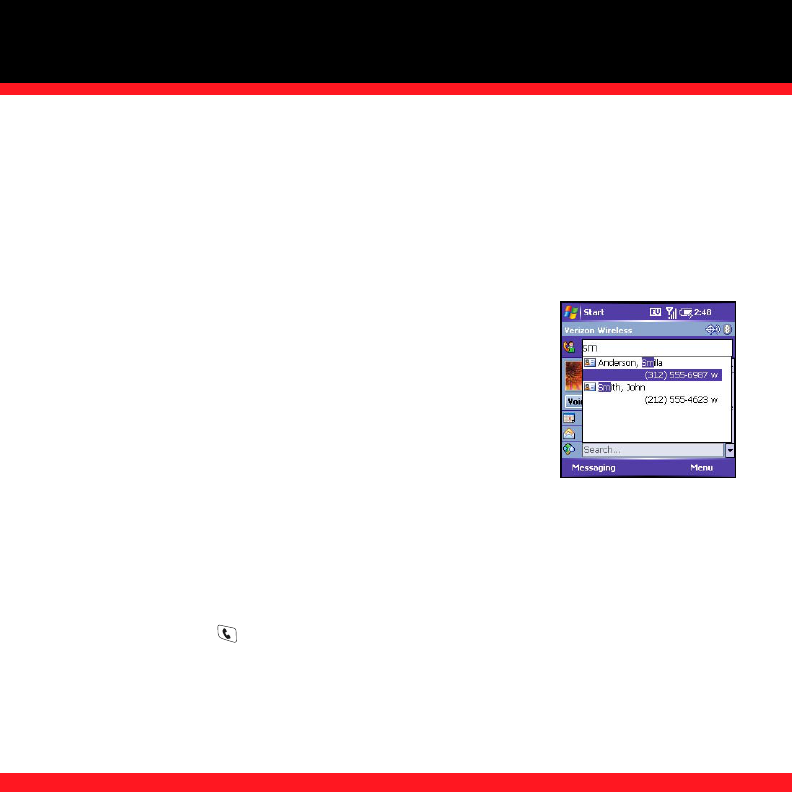
USING YOUR PHONE
23
Dialing by contact name
You can look up contacts quickly by entering just a few letters of a contact’s name or phone
number directly from your Today screen. Before you can dial a call by contact name, you must
create some contacts (see “Adding a contact” on page 36) or import them by synchronizing (see
“Synchronizing contacts and other info” on page 16).
1. Go to your Today screen (see “Using your Today screen” on page 15).
2. Using the keyboard, begin entering one of the following for the
contact you want to call:
■First name (JOH for John)
■Last name (SMI for Smith)
■First initial, a space, and then last initial (J S for John Smith)
■First name and last name (JOH SMI for John Smith)
■Phone number (you don’t need to press Option to access the
number keys)
For example, entering SM finds both Smilla Anderson and John Smith. Entering SM A finds
only Smilla Anderson.
3. Select the number you want to dial.
4. Press Phone/Send to dial.
NOTE To clear the Dial Lookup field and start another Contacts search, press OK. To delete letters when correcting a
misspelled name, press Backspace.
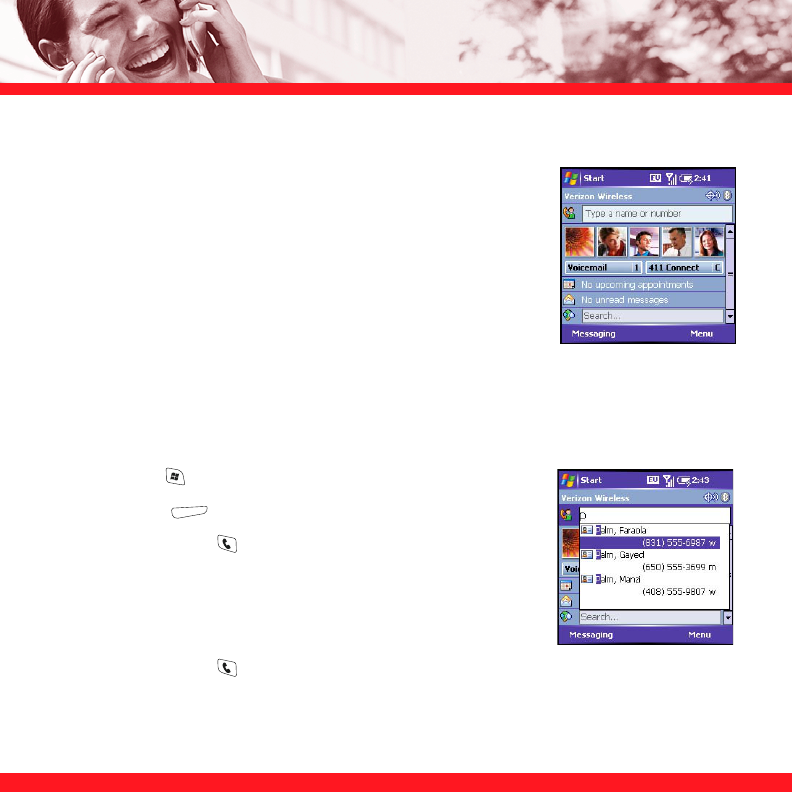
24
Dialing with a speed dial button
Before you can use a speed dial button, you must create some speed
dial buttons. See “Creating a speed dial button” on page 32.
You can dial your speed dial buttons by doing any of the following:
■Select a speed dial button with the 5-way, and then press Center.
■Tap a speed dial button with the stylus.
■Press and hold a Quick Key that you assign to the speed dial
button.
To see more speed dial buttons, highlight the picture speed dial area and press Right or Left
repeatedly, or highlight the text speed dial area and press Up, Down, Right, or Left.
Dialing by company name
1. Press Start and select Contacts.
2. Press Menu and select View By > Company.
3. Press Phone/Send to go to your Today screen.
4. Using the keyboard, begin entering the first few letters of the
company name.
5. Select the number you want to dial.
6. Press Phone/Send to dial.
NOTE Until you change the View By setting, your contact list (in the Contacts application) is also sorted by company name.
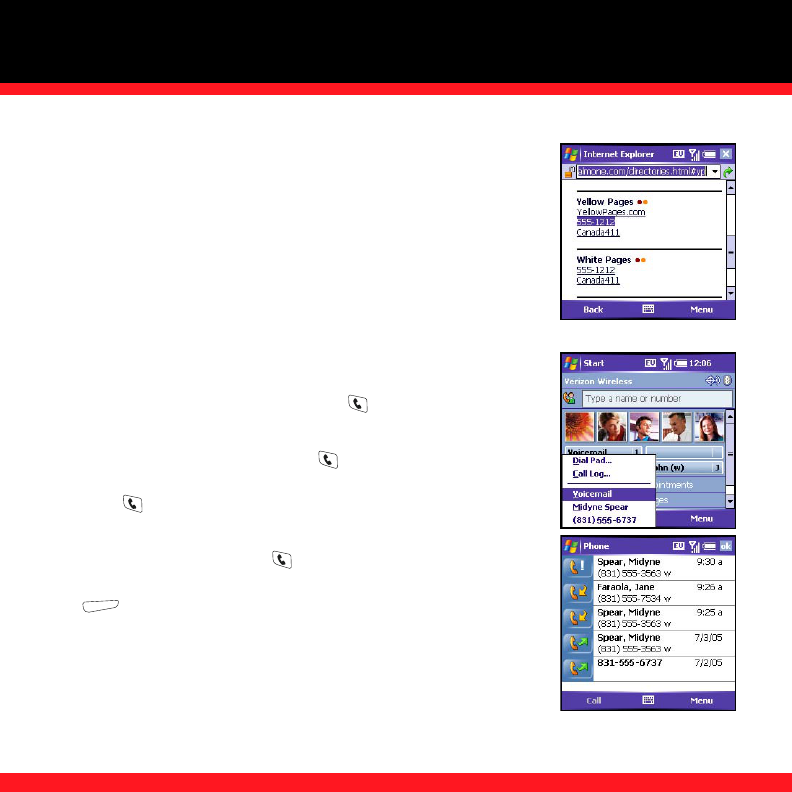
USING YOUR PHONE
25
Dialing from a web page or message
Your smartphone recognizes most phone numbers that appear in web
pages or in messages (text, email, or multimedia).
1. Use the 5-way to highlight the phone number you want to dial in
the web page or message.
2. Press Center to open the Phone dialog box.
3. Select Yes to dial.
Redialing a recently called number
■To dial the last number you called: Go to your Today screen,
and then press and hold Phone/Send .
■To select from your most recently dialed numbers: Go to your
Today screen, press Phone/Send , highlight the number
or contact name you want to call, and then press Phone/
Send to dial.
■To select from a chronological list of calls: Go to your Today
screen, press Phone/Send , and then select Call Log.
Highlight the number you want to call, and then press Call
to dial.
NOTE You can also access the Call Log by going to the Today screen, pressing
Menu, and then selecting Call Log.
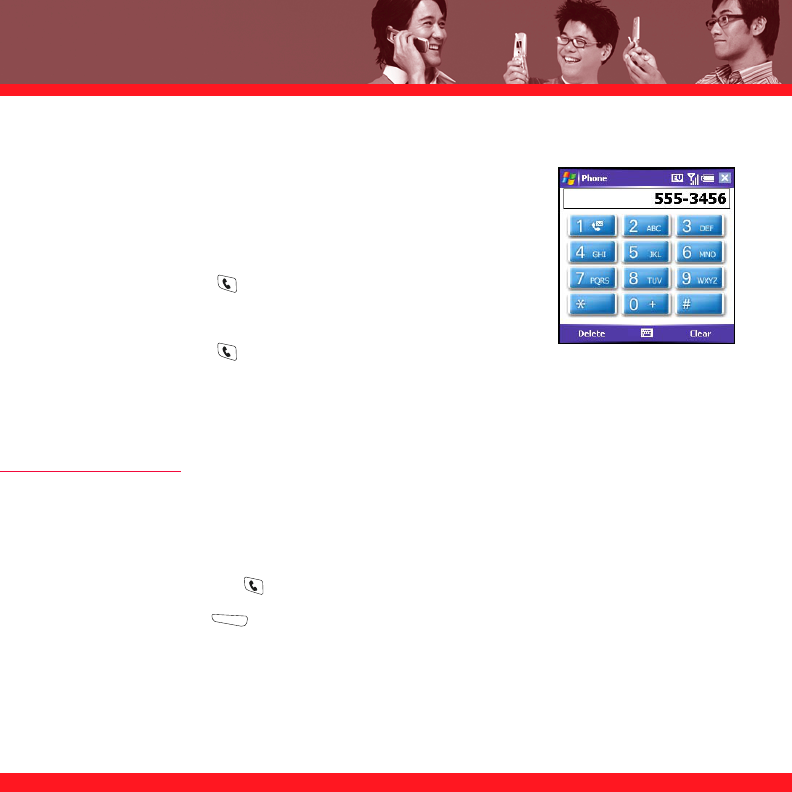
26
Dialing using the onscreen Dial Pad
The onscreen Dial Pad is useful for dialing numbers that are
expressed as letters, such as POPCORN to check the time, and when
you need large numbers that you can tap with your finger or stylus.
1. Go to your Today screen.
2. Press Phone/Send and then select Dial Pad from the menu.
3. Tap the onscreen Dial Pad to enter the number.
4. Press Phone/Send to dial.
NOTE You can paste numbers directly into the Dial Pad. Copy a number from another application, switch to Dial Pad, and
then press and hold Center to paste the number. You can also access the Dial Pad by going to the Today screen, pressing
Menu, and then selecting Dial Pad.
RECEIVING CALLS
To receive calls, your phone must be on. This is different from using your smartphone in Flight
mode.
■To answer a call, do one of the following:
■Press Phone/Send .
■Press Answer .
■If the headset is attached, press the headset button.
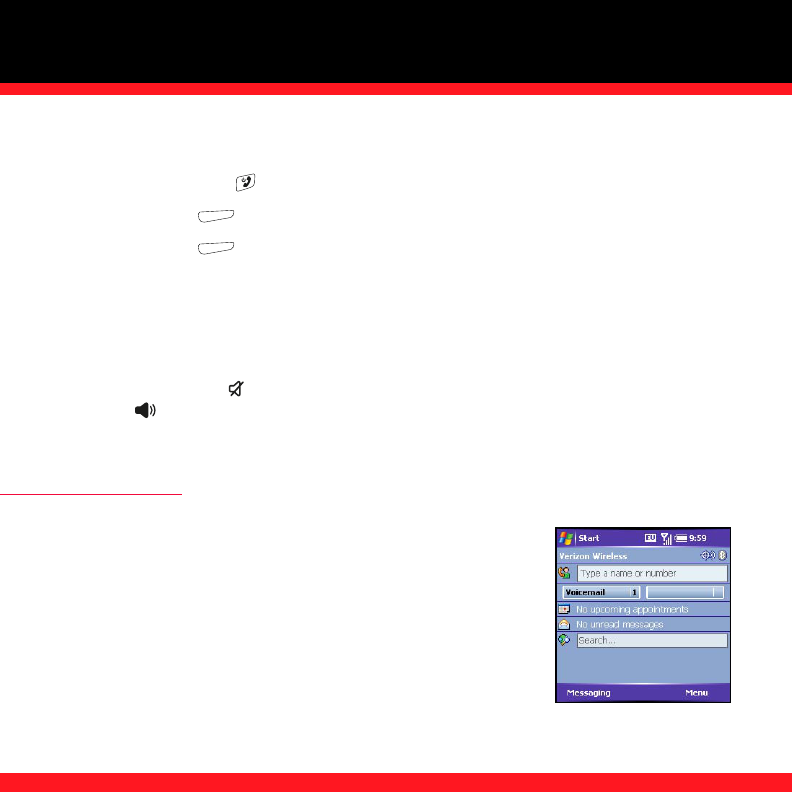
USING YOUR PHONE
27
■To ignore a call, do one of the following:
■Press Power/End .
■Press Menu and select Ignore.
■Press Menu and select Ignore with text message.
■To silence the ringer while your smartphone is ringing:
■Press the Volume button or any key on your smartphone except Phone/Send, Power/End,
or the 5-way.
■To immediately silence all system sounds including the ringer, slide the ringer switch to
Sound Mode Off . All sounds remain off until you slide the ringer switch back to Sound
On .
NOTE When you silence the ringer, you can either answer the call or let it ring through to voicemail.
USING VOICEMAIL
Setting up voicemail
1. Go to your Today screen.
2. Press and hold 1 on the keyboard to dial Verizon Wireless’s
voicemail system.
3. Follow the voice prompts to set up your voicemail.
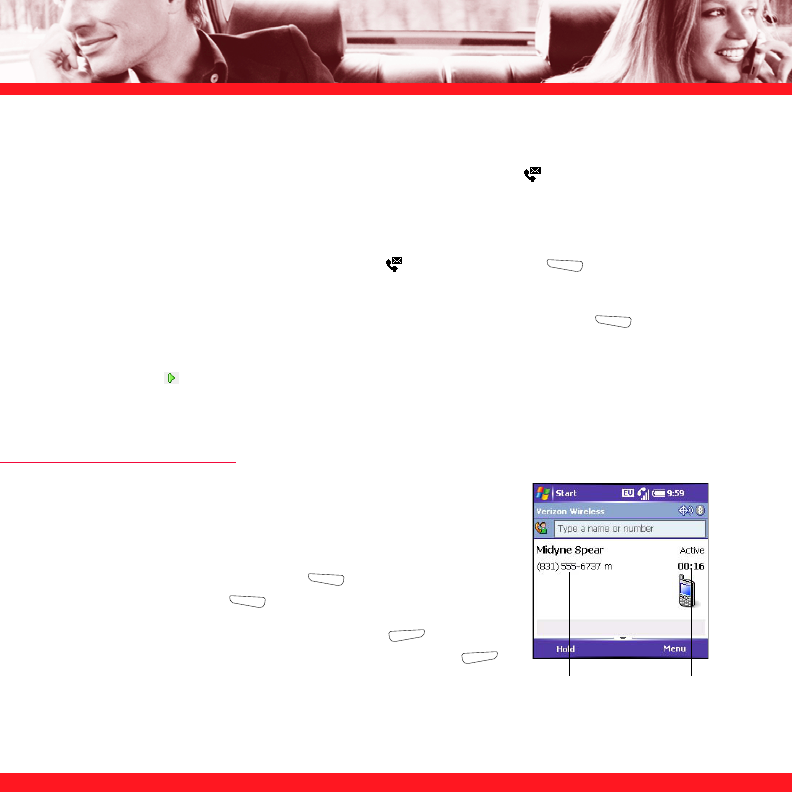
28
Retrieving voicemail messages
When you have unretrieved voicemail messages, a Voicemail icon appears at the top of your
screen and the left action key is labeled Voicemail.
1. Go to your Today screen.
2. Press and hold the 1 key (or tap Voicemail or press Voicemail ) to dial Verizon
Wireless’s voicemail system.
3. Enter your voicemail password using the keyboard, or press Extra Digits if you defined
this option (see “Creating a speed dial button” on page 32 for details).
4. Select Play to listen to your messages.
NOTE You don’t need to press Option to enter numbers, *, or # when responding to voicemail prompts.
MANAGING ACTIVE CALLS
When you make or receive a call, the active call info appears on
your Today screen.
During a call, you can do any of the following:
■Put the call on hold: Press Hold . To take the call off
hold, press Off Hold .
■Use the built-in speakerphone: Press Menu and select
Speakerphone. To return to the earpiece, press Menu
again and select Speakerphone off. Current duration
of call
Caller’s name
and number
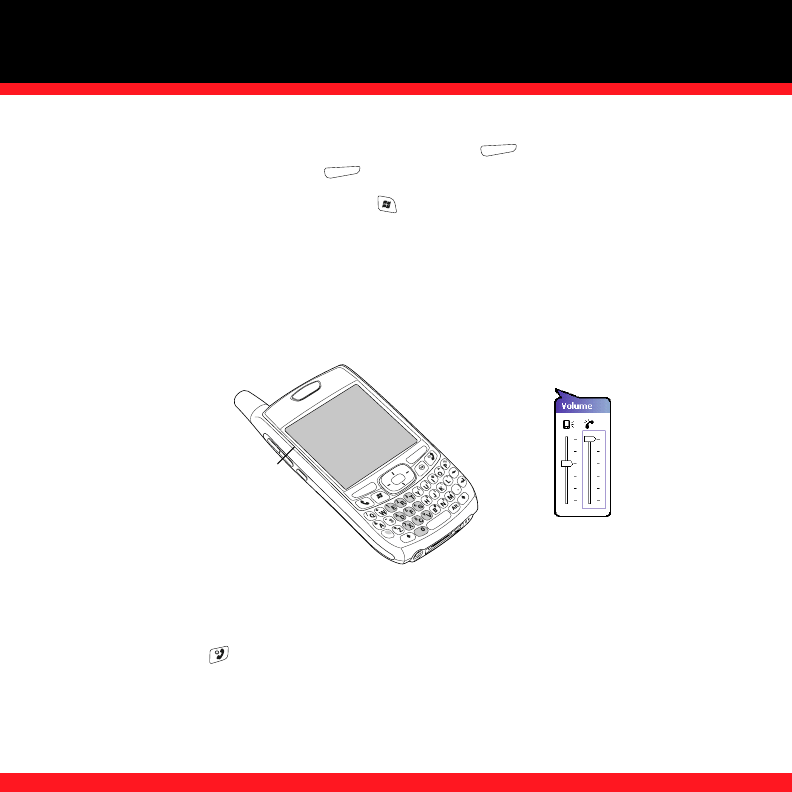
USING YOUR PHONE
29
■Mute the microphone so you can’t be heard: Press Menu and select Mute. To turn the
microphone back on, press Menu again and select Cancel Mute.
■Switch to another application: Press Start and select the application.
NOTE When a call lasts longer than one minute, the screen dims and then turns itself off. Press any key, except Power/End,
to wake up the screen.
Adjusting call volume
While a call is in progress, press the Volume button on the side of your smartphone to adjust
call volume.
Ending a call
Do one of the following:
■Press Power/End .
■Press the headset button (if the headset is attached).
Volume button

30
Returning to an active call from another application
You can use many other applications on your smartphone while holding a phone conversation,
including the organizer and SMS features. You cannot browse the web or send and receive email
or MMS messages while on a voice call.
From any application, press Phone/Send to return to your Today screen.
Saving phone numbers
After you complete a call, you are prompted to add the number if it isn’t in your Contacts list.
■To create a new contact for this number, select Create New Contact.
■To add this number to an existing contact, select Copy and Add, and then select a contact.
■To decline adding the number, press Dismiss .
■To permanently disable the Add Contact prompt, select Don’t show this again.
If you don’t add a number right away, follow these steps to add it later:
1. Go to the Call Log (see “Redialing a recently called number” on page 25).
2. Highlight the number you want to save.
3. Press and hold Center to open the shortcut menu, and then select Save to Contacts.
4. Enter the information for the entry.
5. Press OK .
NOTE You can also save contact info from other applications, such as Messaging. If an incoming call uses caller ID
blocking, you do not see the Add Contact prompt.
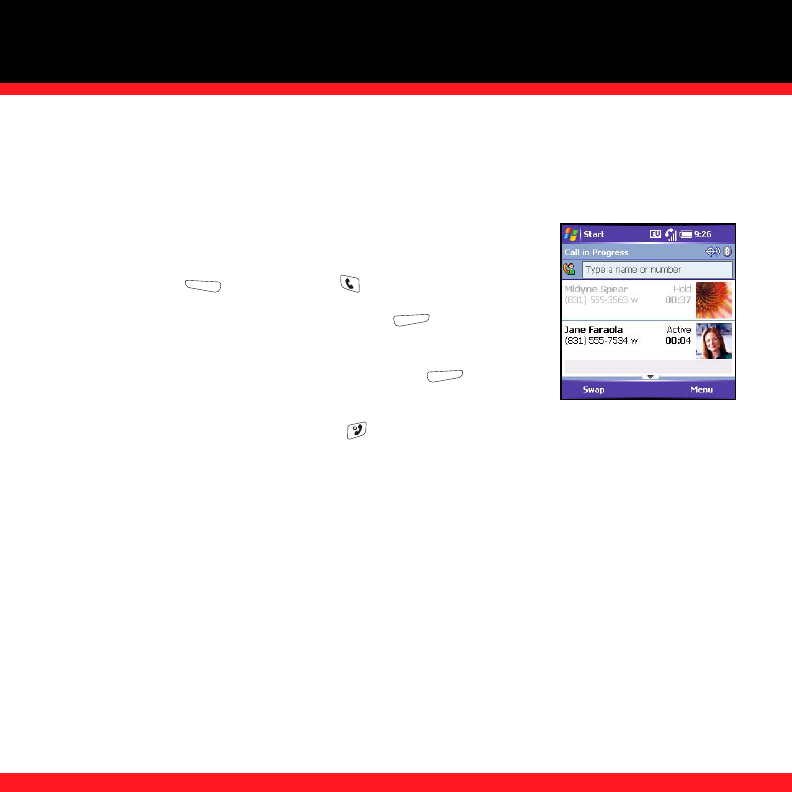
USING YOUR PHONE
31
Answering a second call (call waiting)
When you’re on a call and you receive a second call, the call waiting notification appears. When
the second call is incoming, you can swap between the two calls, but you can’t conference them.
You can do any of the following:
■Place the current call on hold and answer the new call:
Press Answer or Phone/Send .
■Send the new call to voicemail: Press Menu and select
Ignore.
■Send the new caller a text message: Press Menu and select
Ignore with text message.
■Hang up both calls: Press Power/End .
NOTE When two calls are active and you press Power/End, you hang up both calls. To return to the first call, wait for the
person on the second call to hang up.
Making a conference call
When the second call is outgoing, you can join two calls in a conference session. Additional
charges may apply and minutes in your mobile account may be deducted for each active call.
Please contact Verizon Wireless for more information.
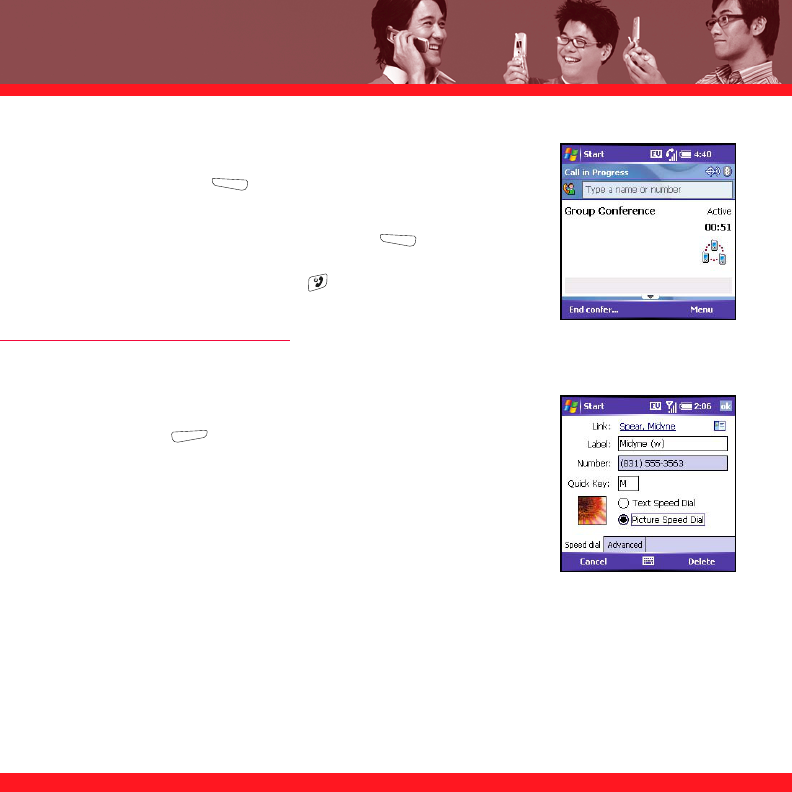
32
1. Put the first call on hold, and then place a second call.
2. Press Conference ; this joins the two active calls in a
conference.
3. When you’re done, press End Conference ; this ends the
second call and returns you to the first call. If you’re ready to hang
up both calls, press Power/End instead.
CREATING A SPEED DIAL BUTTON
You can create up to 20 picture buttons and 50 text buttons.
1. Go to your Today screen.
2. Press Menu and select New Speed Dial.
3. Do one of the following:
■Select Link to contact, select the contact you want to link to
this button, and then select the number you want to dial with
this button.
■Select Label and enter a name for this button, and then select
Number and enter the phone number you want to dial with this button.
4. (Optional) Enter a Quick Key. When the Today screen is showing, you can press and hold the
Quick Key to instantly dial this number.
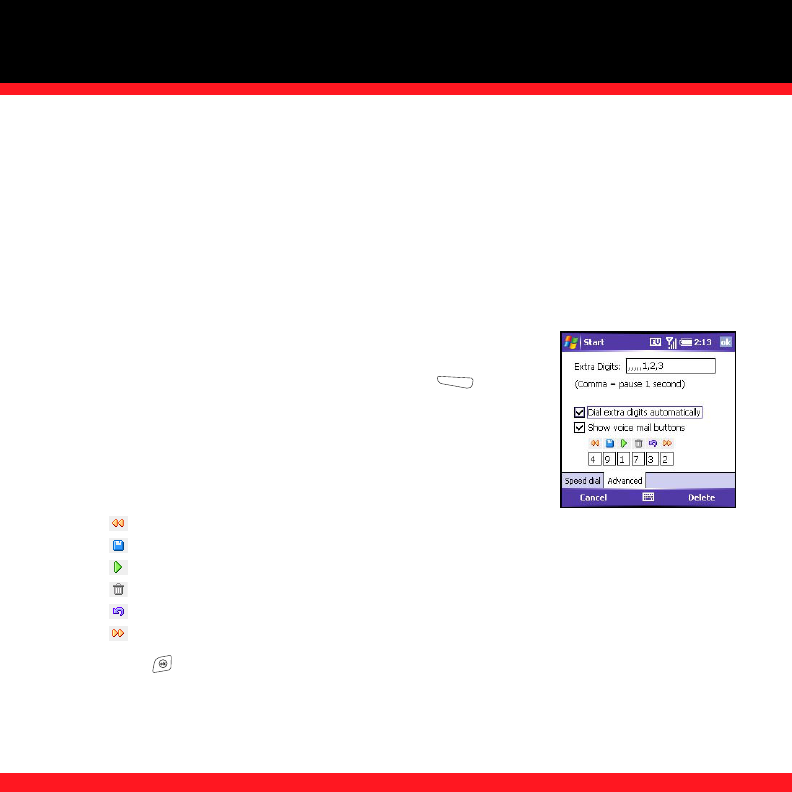
USING YOUR PHONE
33
5. If this button is linked to a contact entry with a picture, select either Text Speed Dial or Picture
Speed Dial to indicate which type of button you want to create. If this button is not linked to a
contact or the contact doesn’t have a picture, the Picture Speed Dial option is not available.
6. (Optional) Select the Advanced tab and set any of the following options:
■Extra Digits: Defines additional numbers to dial, such as a password or extension. In
addition to numbers, you can enter the following symbols: star (*) and pound (#). To
enter a one-second pause, enter a comma (,).
■Dial extra digits automatically: Dials predefined Extra Digits
immediately after dialing the phone number. If you do not
check this box, you need to press Extra Digits to dial
these digits.
■Show voice mail buttons: Displays the voicemail playback
controls after you dial this speed dial number. When this
option is checked, you can enter numbers below each control
to tailor the controls to your voicemail system.
Plays the previous message.
Saves the current message.
Plays the current message.
Deletes the current message.
Repeats the current message.
Plays the next message.
7. Press OK .
NOTE To edit a speed dial button, highlight the button, press and hold Center, and then select Edit Speed Dial from the
shortcut menu.
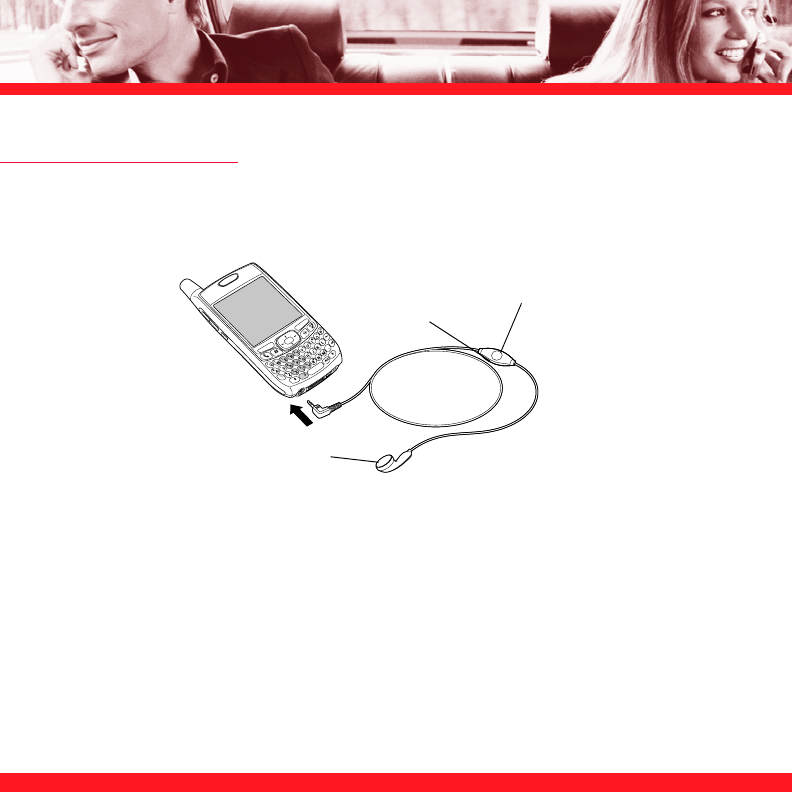
34
USING A PHONE HEADSET
You can connect a phone headset for hands-free operation. If you need to use your smartphone
while driving and this is permitted in your area, we recommend using a phone headset or a
hands-free car kit (sold separately).
The headset button is context sensitive and it performs different actions based on the situation.
You can press the headset button to perform any of the following tasks:
■Answer an incoming call
■Answer a call waiting call
■Hang up all calls
Microphone
Speaker
Headset button

USING YOUR PHONE
35
Headset specifications
Your smartphone works with headsets that have a 2.5mm, 3-pin connector. When in doubt, ask
the third-party headset manufacturer if the product is compatible with Treo 700w smartphones. If
you hear a headset buzz or poor microphone performance, your headset may be incompatible
with your smartphone.
Using a hands-free device with Bluetooth wireless technology
Your Treo smartphone is also compatible with many headsets and car kits enabled with Bluetooth
wireless technology version 1.1 or 1.2. Please note, however, that you cannot use a Bluetooth
headset to listen to MP3 files on your smartphone.
[ ! ] IMPORTANT For a list of compatible hands-free devices with Bluetooth wireless technology, go to:
www.palm.com/mytreo700wVerizon.
To learn how to set up and connect to Bluetooth devices, see “Setting up a Bluetooth®
connection” on page 56. Here are tips for working with a Bluetooth hands-free device:
■To transfer a call from a wired headset to a Bluetooth headset that is within range and with
which you’ve previously set up a partnership (Bluetooth headset required, sold separately),
unplug the wired headset and press the button on the Bluetooth headset.
■To transfer a call from the handset to a Bluetooth hands-free device during a call, press Menu
and select Connect. To transfer the call back to the Bluetooth hands-free device, press
Menu and select Cancel Bluetooth.
NOTE If you have both a compatible Bluetooth headset and car kit, the one you connected to your smartphone last
becomes the active device.
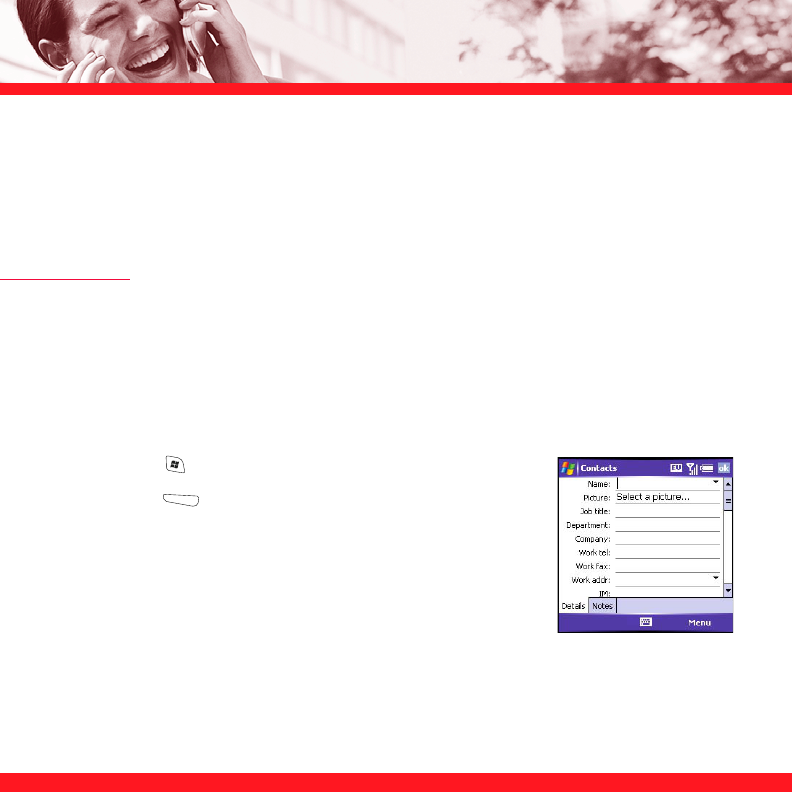
36
STAYING ORGANIZED
This section introduces you to a few of the applications you can use to stay organized. To learn
about the other applications that come with your smartphone, such as Tasks and Notes, see the
User Guide.
CONTACTS
Adding a contact
If you have many contacts to enter, it’s best to enter them in Microsoft® Office Outlook® on your
computer and then sync. See “Synchronizing contacts and other info” on page 16 for details. To
enter a few contacts, follow these steps:
NOTE Be sure to enter mobile numbers and email addresses in the correct fields. Otherwise Messaging can’t find this info
when you address a message, and Calendar can’t find your contacts to invite them to meetings.
1. Press Start and select Contacts.
2. Press New .
3. Use the 5-way to move between fields as you enter information.
4. To add a caller ID picture that appears when that person calls,
select Picture, and then select Camera and take a picture, or
select an existing picture from the Thumbnail screen.
5. To assign the entry to one or more categories, select Categories
and then check the categories under which you want this entry to appear.
6. To add a note to an entry, select the Notes tab.

STAYING ORGANIZED
37
7. To assign a ringtone to the entry, select Ring tone and select a tone.
8. After you enter all the information, press OK .
Viewing or changing contact information
1. In the Contacts list (name view), begin entering one of the following for the contact you want
to view or edit:
■First name
■Last name
■First initial and last initial separated by a space
■Phone number
2. Select the entry you want to open.
3. Press Menu and select Edit.
4. Make changes to the entry as necessary.
5. Press OK .
CALENDAR
Displaying your calendar
1. Press Start and select Calendar.
2. Press Menu and select View.

38
3. Select one of the following views:
■Agenda: Shows your daily schedule in list format. Upcoming appointments are bold, past
appointments are dimmed.
■Day: Shows your daily schedule in day-planner format.
■Week: Shows your schedule for an entire week.
■Month: Shows your schedule for a whole month.
A morning appointment.
An afternoon appointment.
There are both morning and evening appointments.
An all-day event.
■Year: Shows a calendar for a 6-month period.
4. Use the 5-way to move to another day, week, month, or year (based on the current view).
Creating an appointment
If you have several appointments to enter, it’s most efficient to enter them in Microsoft Office
Outlook on your computer and then synchronize your smartphone with your computer. See
“Synchronizing contacts and other info” on page 16 for details.
1. Press Start and select Calendar.
2. Press Menu and select New Appointment.
3. Enter a subject (description) and a location.
4. Select Starts and select the starting date and time.
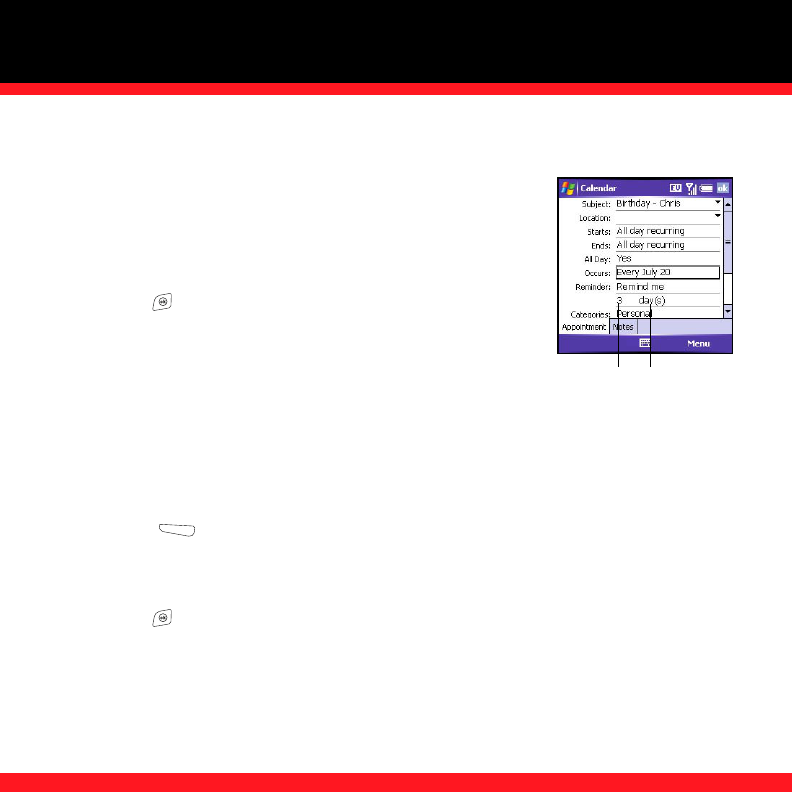
STAYING ORGANIZED
39
5. Select Ends and select the ending date and time.
6. (Optional) Set an alarm:
■Select Reminder, and then select Remind Me.
■Enter the number of minutes, hours, days, or weeks before
the event you want to receive the alarm.
7. Press OK .
NOTE See the User Guide to learn how to change the alarm tones.
Sending a meeting request
You can email meeting invitations to contacts who use Microsoft
Office Outlook or Outlook Mobile.
NOTE Create contact entries with email addresses for the people you want to invite to a meeting. You can’t access contact
entries without email addresses from your calendar.
1. Create an event, and then select it.
2. Press Edit .
3. Select Attendees, and then select the name of the contact you want to invite. To invite other
attendees, select Add and select the names.
4. Press OK .
The next time you synchronize, the meeting request is sent to the attendees. When attendees
accept your meeting request, the meeting is automatically added to their schedules. When you
receive their response, your calendar is updated as well.
Type of
time units
Number of
time units

40
STAYING IN TOUCH
MESSAGING
You can use the Messaging application to exchange email, text messages (SMS), and multimedia
messages (MMS) with other mobile devices and email addresses that support these forms of
messaging. You can also exchange instant messages (IM) with Pocket MSN. Before you use your
smartphone’s messaging features, consult Verizon Wireless for pricing and availability.
Setting up an email account
Before you set up your email account(s) on your smartphone, you must determine which type of
account(s) you want to access, as the steps vary for each account type. The following gives an
overview of the account types, and setup steps for each account type appear later in this section:
■Exchange Server: Enables you to wirelessly synchronize your email and other information
directly with the information stored on a Microsoft Exchange 2003 Server.
■Wireless Sync: Enables you to use a Verizon Wireless Sync account to wirelessly synchronize
your email and other information with the information stored on your computer (Verizon
Wireless Sync account required, additional charges may apply).
■IMAP or POP: Enables you to send and receive email messages with a corporate email
account or an account that you have with an Internet service provider (ISP).
■Hotmail: Enables you to send and receive email messages with an MSN Hotmail account.
NOTE If your email account requires a VPN connection to establish a secure connection, you must install a VPN application
(sold separately) on your smartphone before you can access your email. Visit www.palm.com/mytreo700wVerizon to
purchase a VPN application, and see the electronic User Guide for more info.
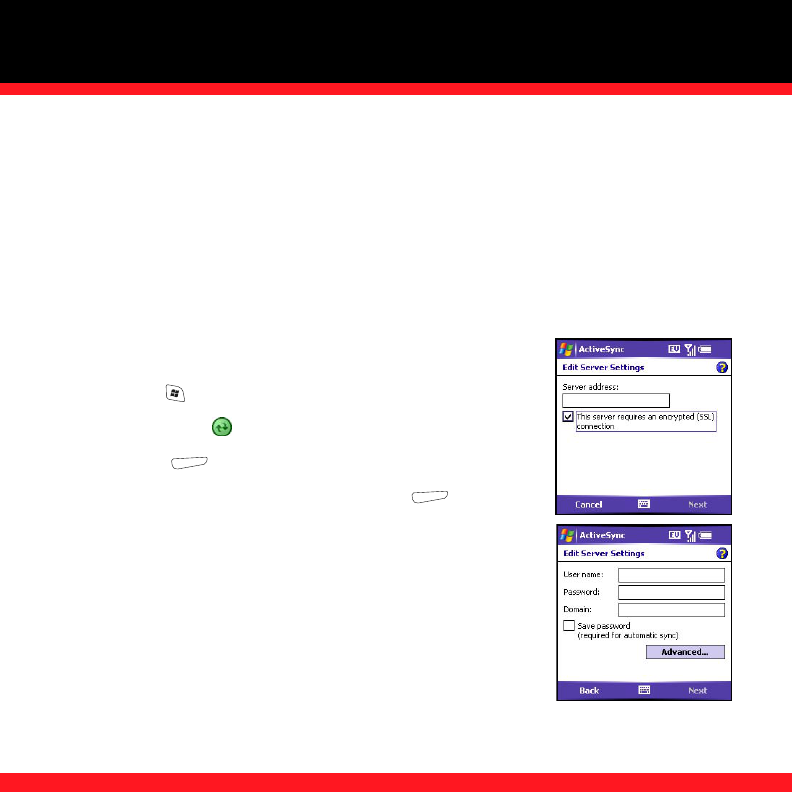
STAYING IN TOUCH
41
Setting up an Exchange Server email account
If you already set up your Exchange Server email settings when you installed the ActiveSync®
desktop software, you do not need to repeat this process. If you did not set up an Exchange
Server email account, follow the steps in this section to set up an account now. Work with your
system administrator to gather the following info:
■Mail server address and domain name
■Your username and password
NOTE The Exchange Server settings are case sensitive. Be sure to enter uppercase and
lowercase letters properly.
1. Press Start and select Programs.
2. Select ActiveSync .
3. Press Menu and select Add Server Source.
4. Enter the Server address, and then press Next .
5. Enter your username, password, and domain.
6. If you want to enter your password each time you access this
account, do not check the Save password box. If you want your
password entered automatically, check this box.
7. (Optional) Select Advanced to set the rules for fixing sync
conflicts.
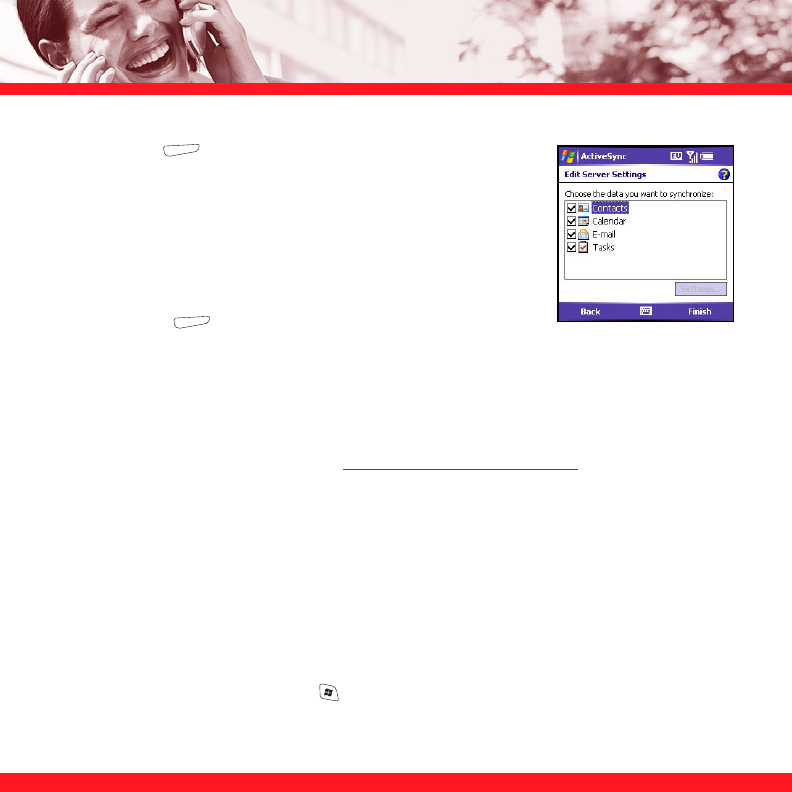
42
8. Press Next and check the boxes for the types of
information you want to synchronize with Exchange Server.
9. (Optional) Highlight an item and select Settings to change the
synchronization settings for that type of information.
NOTE Settings are not available for all items. If you want to download more than the
email message header, select E-mail and increase the KB setting. If you don’t increase
this setting, you can manually download the rest of the message at your convenience.
10. Press Finish .
Setting up a Wireless Sync email account
To use Wireless Sync, you must first install the desktop synchronization software that came with
your smartphone, and you must subscribe to Verizon Wireless’s Wireless Sync feature
(additional charges may apply).
1. If you haven’t already done so, go to http://www.wirelesssync.vzw.com to do the following:
■Create your Wireless Sync account. Click Register and then Setup Wireless Sync Now.
■Make sure your phone is on (see “Turning your smartphone on/off” on page 3), click Next
and then follow the onscreen instructions.
■When prompted, enter a temporary password and then select an official password.
■Indicate which email accounts you want to use with this feature. (This may require info
about your mail server from your system administrator.)
■Install the Wireless Sync desktop software.
2. On your smartphone, press Start and select Programs.

STAYING IN TOUCH
43
3. Select Wireless Sync .
4. Press Start and then wait a few minutes for the installation to complete.
5. When the following message appears on your smartphone screen: Have you created your
Wireless Sync account yet?, select Yes.
6. Select Sync near the top of the screen.
7. When the Authentication dialog box appears, enter the password for your Wireless Sync
account.
8. When the First Synchronization dialog box appears, do one of the following based on the type
of email account you set up:
■Corporate email or Both: Select Refresh.
■Internet email: Select Merge.
For corporate email accounts, the default settings do a wireless sync whenever info changes in
Microsoft® Office Outlook®. To find out how often you can expect message delivery, contact your
system administrator and ask about your company’s server settings. For Internet email accounts,
the default settings do a wireless sync every 30 minutes. To customize your Wireless Sync
settings, select Setup at the bottom of the screen, and then select Push/ReadySync.
Setting up an IMAP or POP email account
You can send and receive email messages with an email account that you have with an Internet
service provider (ISP), an email account that you access using a VPN server connection (such as
a work account), or any other IMAP (Internet Message Access Protocol) or POP email account.
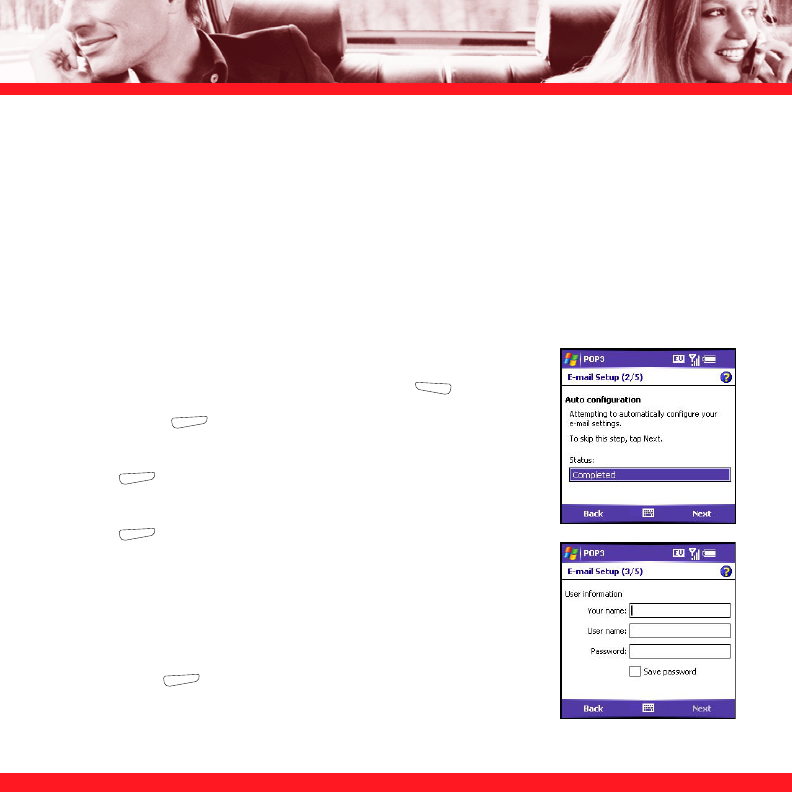
44
Work with your system administrator to gather the following info:
■Account type (POP3 or IMAP)
■Mail server name for receiving mail
■Mail server name for sending mail
■Your username and password
■Domain name
■Any special security requirements
1. Go to your Today screen and press Messaging .
2. Press Menu and select Tools > New Account.
3. Enter the email address that you want to set up, and then press
Next .
4. Wait until the Status box displays Completed, and then press
Next .
5. Enter your name, username, and password.
6. If you want to enter your password each time you access this
account, do not check the Save password box. If you want your
password entered automatically, check this box.
7. Press Next .
8. Select the Account type list, and then POP3 or IMAP.
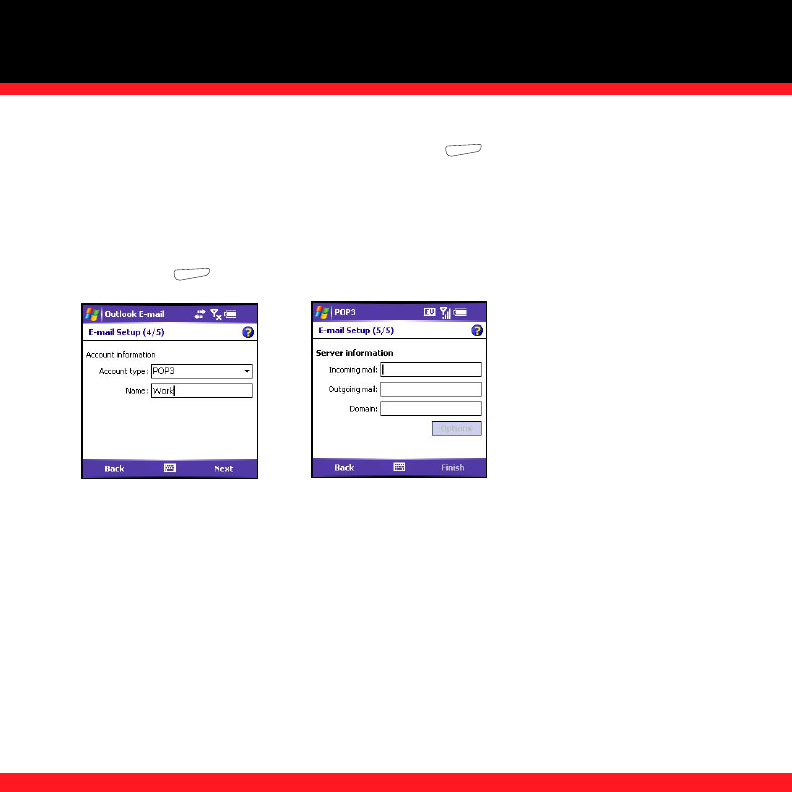
STAYING IN TOUCH
45
9. Enter a name for this account, and then press Next . For example, if this is your work
email account, enter “Work” or your company’s name.
10. Enter the name of the incoming mail and outgoing mail servers and the domain.
11. (Optional) Select Options to set this account’s download options.
12. Press Finish .
NOTE To delete an email account, press Menu and select Tools > Options. Highlight the account you want to delete. Press
and hold Center, and then select Delete.
Signing in to Pocket MSN
Pocket MSN provides quick access to the following:
■MSN Hotmail: Lets you read, write, send, and delete email, and manage your Hotmail folders.
■MSN Messenger Contacts list: Lets you see who’s online and exchange instant messages
(IM). Subscribe to status updates for selected contacts so you’re notified when they’re online.
■Options: Lets you customize your Pocket MSN experience.
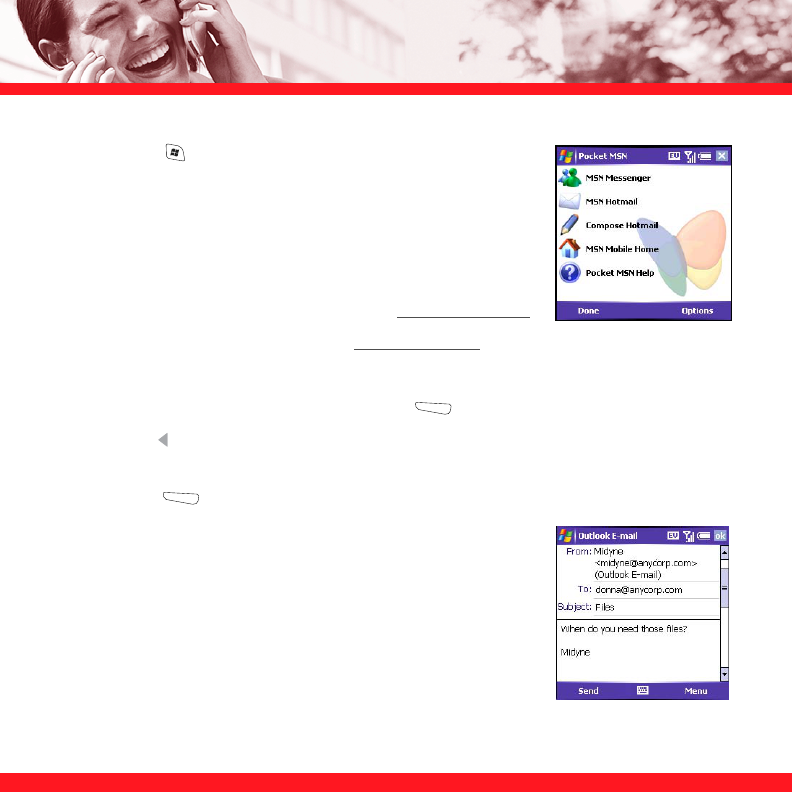
46
1. Press Start and select Pocket MSN.
2. Select MSN Mobile Home.
3. Select Sign in.
4. Enter the email address and password for your Passport account
or your Hotmail account.
■To create a Passport (IM) account, go to www.passport.com.
■To create a Hotmail account, go to www.hotmail.com.
Creating and sending an email message
1. Go to your Today screen and press Messaging .
2. Press Left to cycle through your Messaging accounts until you see the email account you
want to use in the title bar.
3. Press New .
4. Do one of the following to address the message:
■If the recipient’s name and email address are in your Contacts
list, enter the first few letters of the recipient’s first or last
name, and then select the recipient’s name.
■If the recipient’s name and email address are not in your
Contacts list, enter the full email address.
NOTE To send a message to multiple recipients, separate the addresses with a
semicolon (;).

STAYING IN TOUCH
47
5. Select Subject and enter a title for the message.
6. Enter your message, or press Menu , select My Text, and then select a predefined
phrase you want to insert.
7. (Optional) Do any of the following:
■Press Menu and select Insert. Select the type of item you want to attach, and then
select the file or record a voice note.
■Press Menu and select Spell Check.
■Press Menu and select Message Options. Select the Priority list, select a setting for
the message, and then press OK .
8. Press Send .
NOTE If you have difficulty sending mail, try changing your outgoing mail settings to the following:
User name: [9-digit phone number]@vzwmail.net (6505551212@vzmail.net), Password: Your www.vtext.com password,
Outgoing Server: smtp.vzwmail.net. For details on accessing these settings, see “Finding Help” in the User Guide. To keep a
copy of your outgoing messages in the Sent folder, you must turn on this setting. See “Customizing your Messaging
settings” in the User Guide for details.
Synchronizing your email
During synchronization, new messages are copied to your smartphone’s Inbox, and messages in
the smartphone’s Outbox are sent. Your computer must be connected to the Internet when you
sync your email.
To sync your default email account, simply sync your smartphone with your computer. See
“Synchronizing contacts and other info” on page 16 for details. To sync additional email
accounts, such as an Internet Service Provider (ISP) account or a work account that you access
using a VPN server connection, follow these steps:

48
1. Go to your Today screen and press Messaging .
2. Press Left to cycle through your Messaging accounts until you see the account you want to
download in the title bar.
3. Press Menu and select Send/Receive to sync your smartphone with your email server.
Receiving attachments
1. Select the attachment (below the subject) to mark it for download.
2. Sync the email account that contains the message (as described in the previous sections).
3. Select the attachment to open it.
To automatically download attachments from an Outlook E-mail account, do the following:
1. Press Start and select Programs.
2. Select ActiveSync .
3. Press Menu and select Options.
4. Select E-mail, and then select Settings.
5. Check the Include file attachments box, and then press OK .
To automatically download attachments from an IMAP4 email account (typically an ISP account)
or an account that you access using a VPN server connection, do the following:
1. Go to your Today screen and press Messaging .
2. Close any open messages, and then press Menu and select Tools > Options.
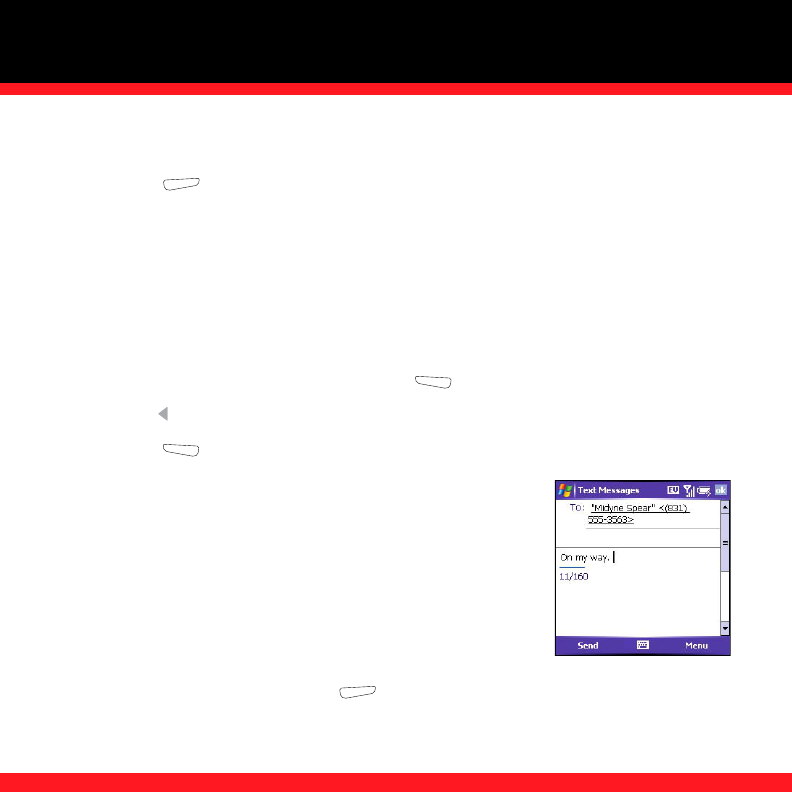
STAYING IN TOUCH
49
3. On the Accounts tab, select the IMAP4 account name.
4. Press Next until you reach Server information, and then select Options.
5. Press Next twice, and then select Get full copy of messages and When getting full copy, get
attachments.
Creating and sending a text message
Each text message can hold up to 160 characters. To save time, you can select from predefined
My Text phrases, such as “Call me” or “On my way.” You can add your own My Text phrases, and
if you prefer, you can enter the full message text too.
1. Go to your Today screen and press Messaging .
2. Press Left until you see Text Messages in the title bar.
3. Press New .
4. Do one of the following to address the message:
■If the recipient’s name and mobile number are in your
Contacts list, press Center, enter the first few letters of the
first or last name, and then select the name.
■If the recipient’s name and mobile number are not in your
Contacts list, enter the full mobile number.
NOTE To send a message to multiple recipients, separate the addresses with a
semicolon (;). If you send a message to three people, you are billed for three messages.
5. Enter your message, or press Menu , select My Text, and then select a predefined
phrase you want to insert.

50
6. (Optional) Press Menu and select Spell Check.
7. (Optional) Press Menu and select Message Options. Enter a callback number and then
select OK.
8. Press Send .
Creating and sending a multimedia message
Multimedia messages can include any of the following items presented as one or more slides:
NOTE Even if your smartphone does not include a camera, you can still send, receive, and view pictures and videos.
1. Go to your Today screen and press Messaging .
2. Press Left until you see MMS in the title bar.
3. Press New .
4. Do one of the following to address the message:
■If the recipient’s name and mobile number or email address are in your Contacts list,
press Center, select Add Recipient, enter the first few letters of the recipient’s first or last
name, and then select the recipient’s name.
■Ringtones
■MIDI
■Sound clips
■WAV
■QCELP
■Pictures
■JPEG
■GIF
■BMP
■Videos
■3G2
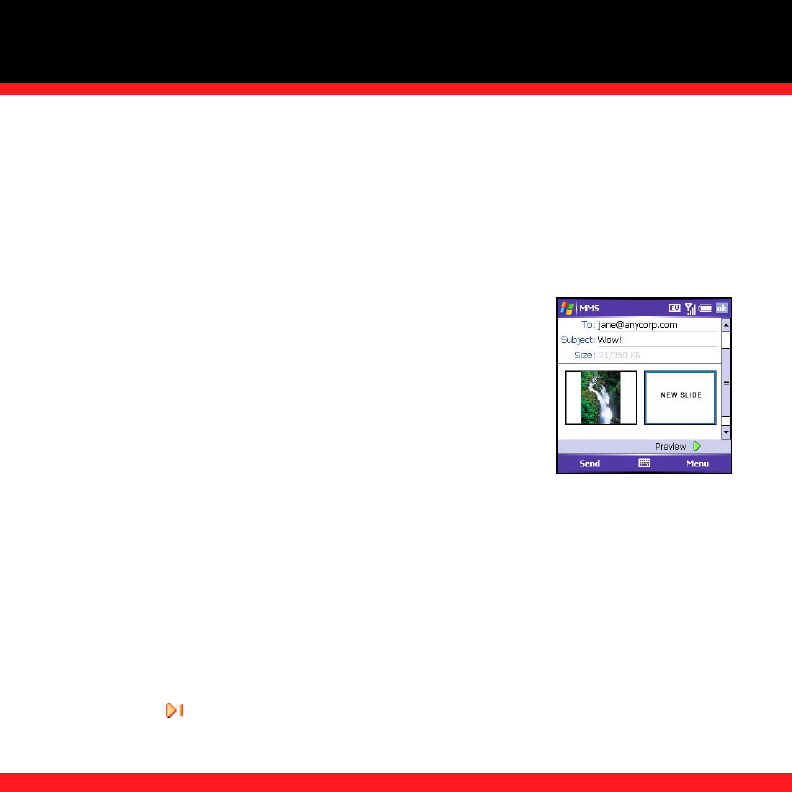
STAYING IN TOUCH
51
■If the recipient’s name and mobile number or email address are not in your Contacts list,
enter the full mobile number or email address.
■If you want to upload a picture or video to your Verizon Wireless PIX Place account, press
Center, and then select PixPlace.
NOTE To send a message to multiple recipients, separate the addresses with a semicolon (;). If you send a message to
three people, you are billed for three messages.
5. Select Subject and enter a title for the message.
6. Select New Slide.
7. Press Center and select one of the following:
■Add Picture: Lets you insert a picture. You can take the
picture with the built-in camera or insert an existing picture.
■Add Video: Lets you insert a video. You can capture a video
with the built-in camera or insert an existing video clip. If you
insert a video, you cannot add a sound to the same slide; to send a sound, add another
slide to your message.
■Add Sound: Lets you record a message, such as a voice caption for a picture, or insert an
existing sound, such as a ringtone. You can add one sound per slide; to send more than
one sound in a message, add another slide to your message. If you capture a picture with
the built-in camera and save it with a voice caption, the voice caption does not count as a
sound file.
8. Enter a text caption or message for the item you inserted.
9. Select Next and repeat steps 8–9 to add other items in this message.
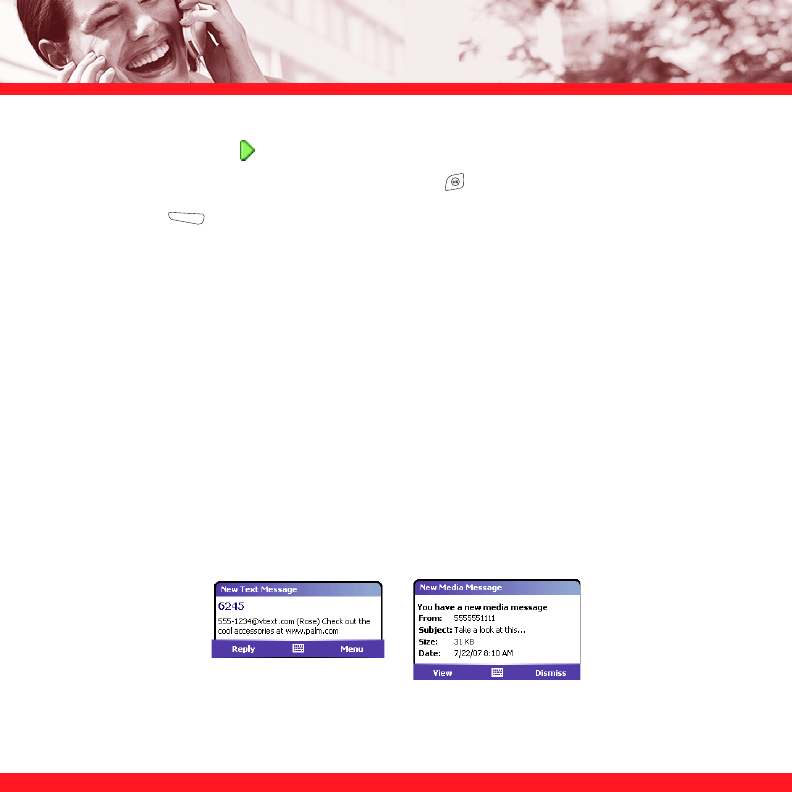
52
10. (Optional) Select Play to view the message as the recipient will see it.
11. When you’re done creating the message, press OK .
12. Press Send .
Receiving text and multimedia messages
When your phone is on and in a wireless coverage area, you automatically receive new text
messages. For multimedia messages, you can set your smartphone to automatically download
new messages or to notify you that messages are ready to download. You can also set your
smartphone to notify you when a new text or multimedia message arrives.
The new message notification may include any of the following options:
■View: Opens the message so you can view its full contents.
■Download: Downloads the rest of the message from the server.
■Reply: Opens a message addressed to the sender’s phone number.
■Dismiss: Closes the notification and puts the message in your Inbox.
■Menu: Opens a menu where you can select other options.
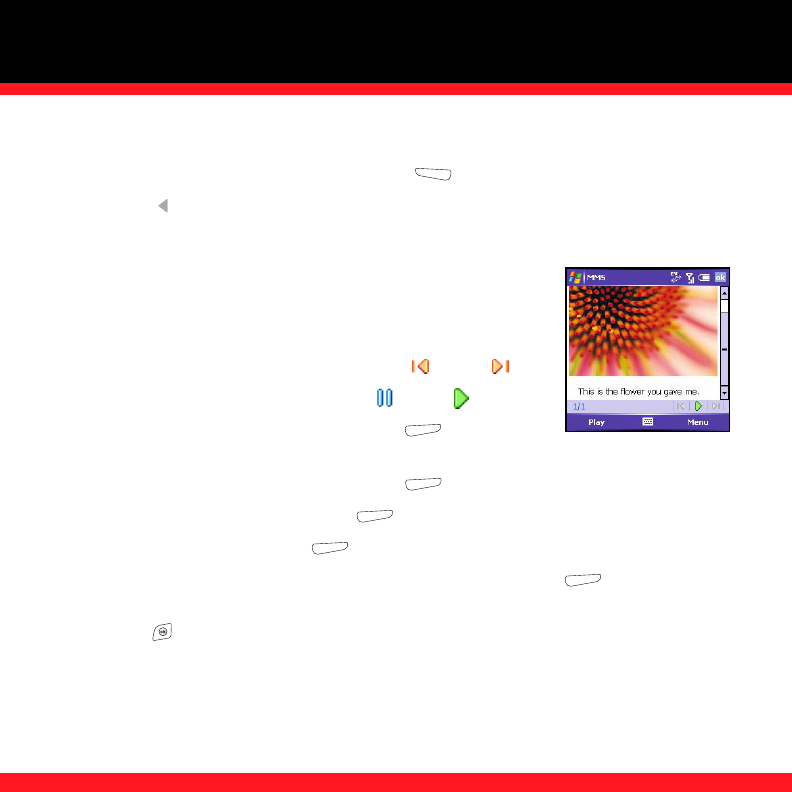
STAYING IN TOUCH
53
Viewing/playing a multimedia message
1. Go to your Today screen and press Messaging .
2. Press Left until you see MMS in the title bar.
3. From the Inbox, select the message you want to view.
4. If you’re viewing the message for the first time, playback begins
automatically. Otherwise, select an item to play.
5. Do any of the following:
■Go the previous or next slide: Tap Previous or Next .
■Pause or resume playback: Tap Pause or Play .
■Save the item that is playing: Press Menu and
select Save.
■Go to the top of the message: Press Menu and select Message Overview.
■Reply to the message: Press Menu and select Reply or Reply All.
■Call the sender: Press Menu and select Call Sender.
■Save the message as a template for other messages: Press Menu and select Save to
Template.
6. Press OK .
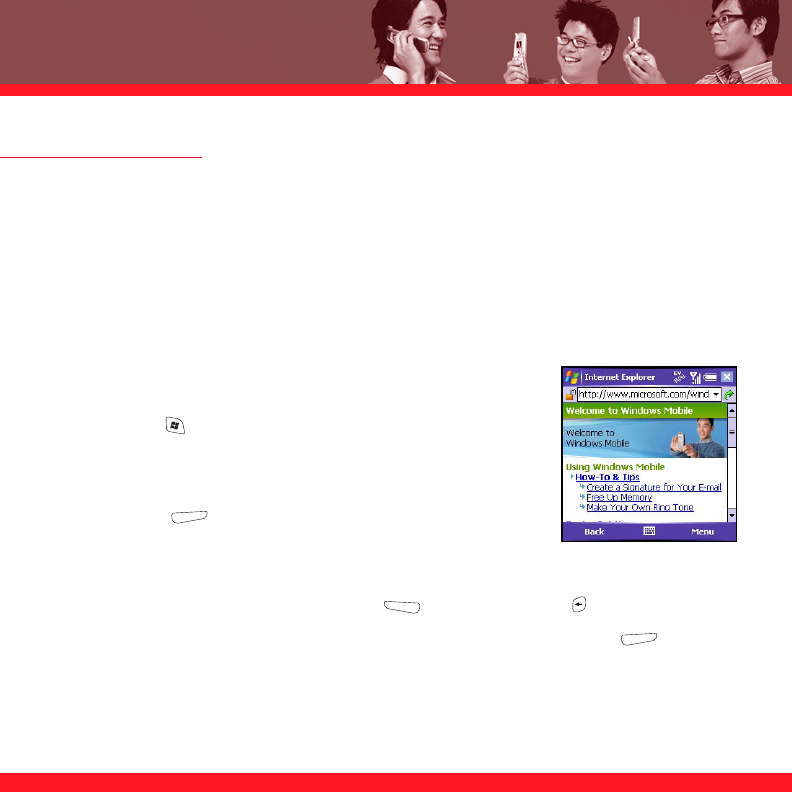
54
BROWSING THE WEB
Internet Explorer Mobile provides quick and easy access to web pages. You can view most sites
you use on your computer, including those with security and advanced features, such as
JavaScript and frames. To browse the web, you must subscribe to data services from Verizon
Wireless.
Viewing a web page
By default, Internet Explorer Mobile scales web page content to fit your smartphone screen so
that you can view most of the information without scrolling left or right.
1. Make sure your phone is on (see “Turning your phone on and off”
on page 3).
2. Press Start and select Internet Explorer.
3. Highlight the address line, enter the address of the web page you
want to view, and then press Center.
4. Press Menu , select View, and then select one of the
available formats.
5. Do any of the following:
■To view the previous page, press Back or press Backspace .
■To refresh the page with the latest content from the Internet, press Menu and select
Refresh.
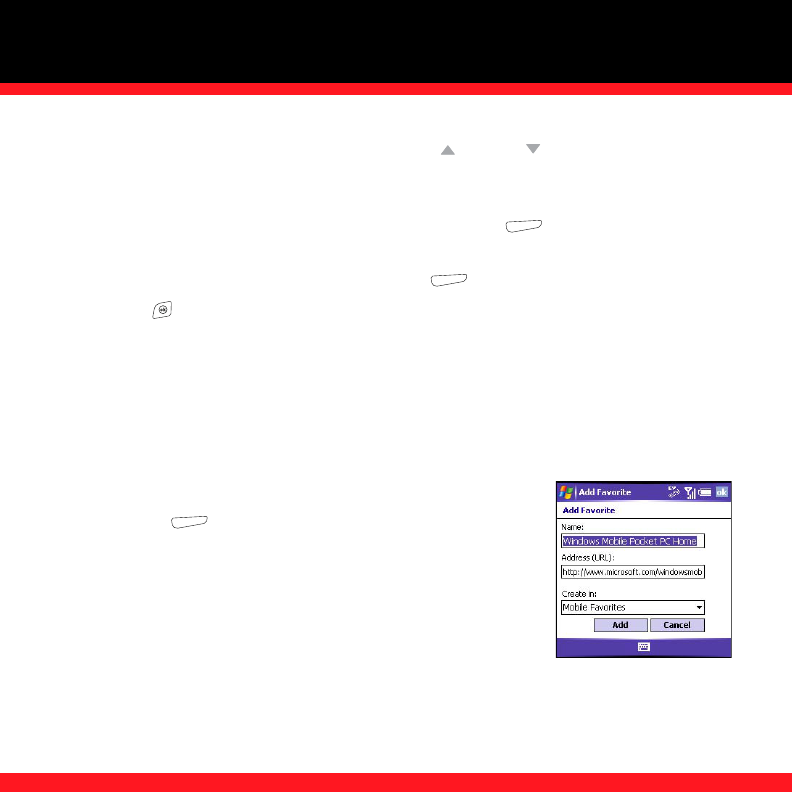
STAYING IN TOUCH
55
■To follow a link to another web page, press Up or Down to highlight the link, and
then press Center to go to the selected page. You can also tap the link on the screen with
your stylus.
■To adjust the size of the text on web pages, press Menu , select Zoom, and then
select the size you want.
■To view a web page’s properties, press Menu and select Tools > Properties.
6. Press OK to close Internet Explorer Mobile.
Creating a favorite
Favorites let you bookmark a web page so that you can instantly access it without entering the
web address. Be sure to check out the built-in favorites for cool downloads.
1. Create the folders where you want to store your favorites. (Once you create a favorite, you
can’t move it to another folder.)
2. Go to the page you want to mark as a favorite.
3. Press Menu and select Add to Favorites.
4. (Optional) Select Name and enter a different description.
5. (Optional) Select the folder where you want to create the favorite.
6. Select Add.

56
Downloading files and images from a web page
You can download files that are usable on your smartphone, such as new applications, MIDI
ringtones, or pictures that are specifically tagged for download.
1. Go to the page that contains the link to the file you want to download.
2. Press Left or Right to highlight the link to the file.
3. Press and hold Center, and then select Save As to download a file, or tap and hold and select
Save Image to download an image.
4. Select Name and enter a new name for the file.
5. Select the Folder list, and then select the folder where you want to save the file.
6. Select the Location list, and then select where you want to store the file: Main memory or
Storage card.
7. Press OK .
SETTING UP A BLUETOOTH® CONNECTION
With your smartphone’s built-in Bluetooth® wireless technology, you can connect to a number of
Bluetooth devices such as a headset, hands-free car kit, or GPS receiver, as well as to other
phones, handhelds, or piconets. If your computer is enabled with Bluetooth wireless technology,
you can also synchronize wirelessly.
[ ! ] IMPORTANT For a list of hands-free devices with Bluetooth wireless technology that are compatible with your
smartphone, go to www.palm.com/mytreo700wVerizon.
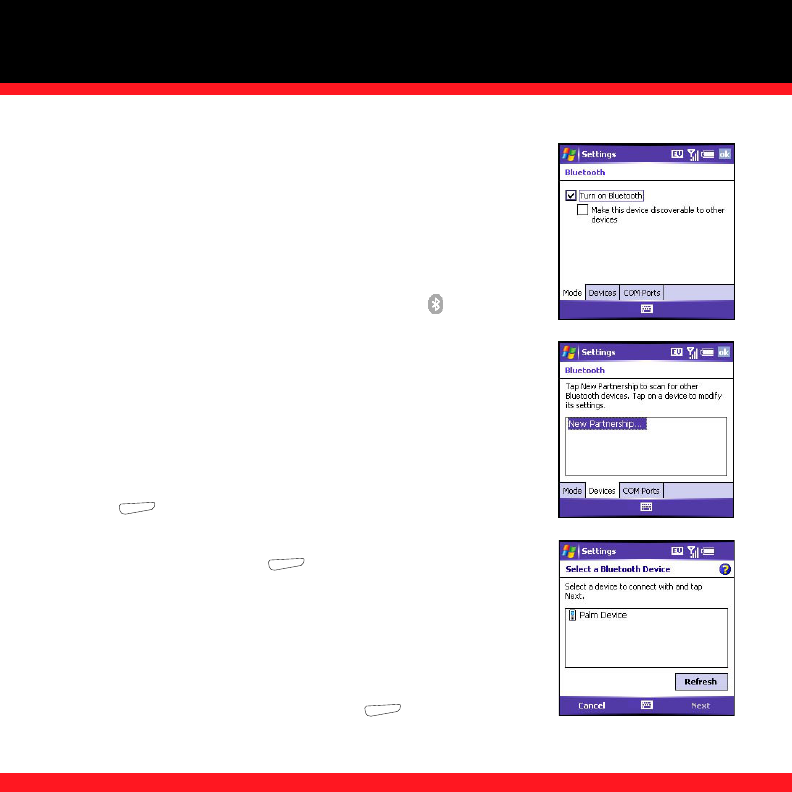
STAYING IN TOUCH
57
After you set up a connection with a Bluetooth device, you can
communicate with that device whenever it is within range (about
30 feet) and your smartphone’s Bluetooth feature is turned on.
1. If necessary, prepare the device you want to connect with to
accept a new connection. Check the device’s documentation
for details.
2. Go to your Today screen, and then tap Bluetooth .
3. Check the Turn on Bluetooth box to turn on your
smartphone’s Bluetooth feature.
4. Select the Devices tab, and then select New Partnership.
5. Wait for your smartphone to search for devices and to display
the device list.
6. Select the device you want to connect with, and then press
Next .
7. Enter an alphanumeric passkey between 1 and 16 characters
long, and then press Next .
[ ! ] IMPORTANT Some Bluetooth devices have a built-in passkey; others let
you choose the passkey. See the documentation for the Bluetooth device for more
info.
8. If the passkey is not built-in, enter the same passkey on the
Bluetooth device, and then press Finish .

58
9. If you’re connecting to a headset or hands-free car kit, check the Hands Free box, and then
press Finish .
10. If you’re connecting to a GPS device, press Finish , select the COM Ports tab, select the
GPS device you selected in step 6, and then select New Outgoing Port. Press Finish .
11. Press OK .
12. If you’re connecting to a GPS device, enter your GPS Settings (see the electronic User Guide
for more info). Be sure to select the same port you selected in step 10.
You can now communicate with this device whenever it is within range (about 30 feet) and your
smartphone’s Bluetooth feature is turned on (see steps 1 and 2 earlier in this section). If you’re
using a hands-free Bluetooth device and it is within range (30 feet), your smartphone routes all
calls to the hands-free device instead of your smartphone’s earpiece. When a call comes in, your
smartphone rings and the car kit or headset beeps. Even if you pick up the call on your
smartphone earpiece, the call goes to the headset or car kit.

STAYING IN TOUCH
59
Beaming a record
1. Highlight the entry or file you want to beam.
2. Press Menu and select Beam… (the menu item changes names based on the type of
item you highlighted).
3. Do one of the following:
■Bluetooth: When the name of the receiving device appears, tap the Tap to send link to
begin the transfer.
■Infrared: Point the IR port on your smartphone directly at the IR port of the receiving
device.
4. Wait for “Done” to appear next to the name of the receiving device before you continue using
your smartphone.
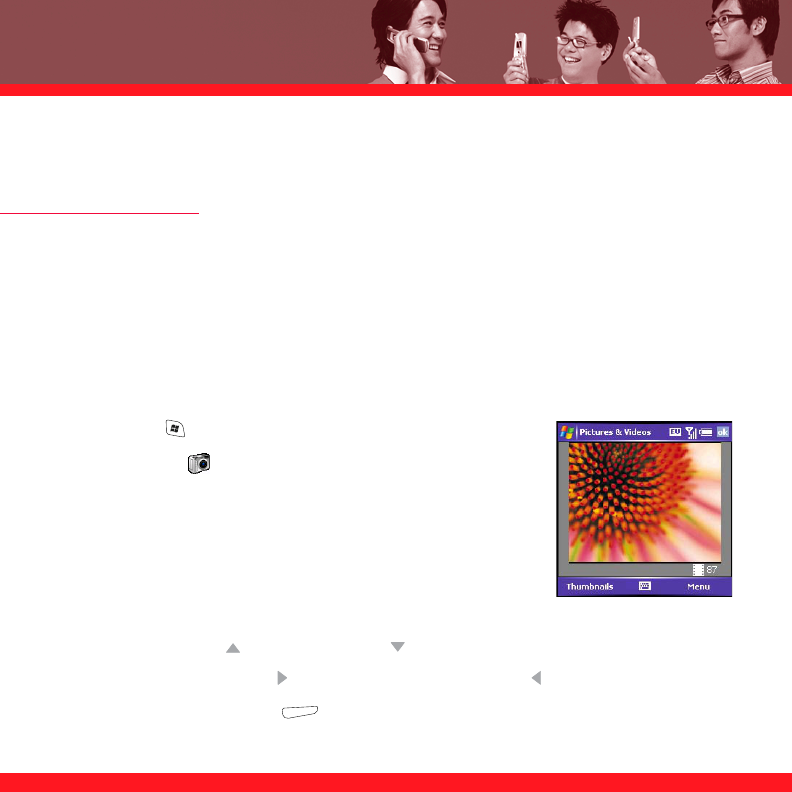
60
PLAYING MEDIA FILES
PICTURES & VIDEOS
Your smartphone comes with a built-in, 1.3-megapixel camera with 2x digital zoom (camera not
included with all smartphones). You can use the camera to take, view, and send pictures and
videos, and to add a personal touch to your smartphone, use your pictures as your Today screen
background and as caller ID images, or use your videos to create video ringtones.
Taking a picture
By default, pictures are stored in the My Pictures folder on your smartphone. If you want to store
your pictures on an expansion card, see the electronic User Guide for instructions.
1. Press Start and select Pictures & Videos.
2. Select Camera .
NOTE If you see a camcorder icon below the preview image, video mode is on. To turn
on the still camera, press Menu and select Still Mode. If you don’t see a camcorder icon,
skip this step.
3. Adjust the position of your smartphone until you see the subject
you want to photograph on the screen.
4. (Optional) Adjust any of the following:
■Zoom: Press Up to zoom in or Down to zoom out.
■Brightness: Press Right to increase the brightness or Left to decrease the brightness.
■Resolution: Press Menu and select Resolution to change the image quality.

PLAYING MEDIA FILES
61
5. Press Center to capture the picture.
6. Hold your smartphone still until the picture renders, and then do one of the following:
■Press Camera to take another picture.
■Press OK to return to the Thumbnails View.
Recording a video
Videos can be any length, provided you have ample storage space available. By default, videos
are stored in the My Pictures folder on your smartphone. If you want to store your videos on an
expansion card, see the electronic User Guide for instructions.
1. Press Start and select Pictures & Videos.
2. Select Camera .
3. Press Menu and select Video Mode.
4. Adjust the position of your smartphone until you see the subject you want to record on the
screen.
5. (Optional) Adjust any of the following:
■Brightness: Press Right to increase the brightness or Left to decrease the brightness.
■Resolution: Press Menu and select Quality to change the video resolution.
6. Press Center to start recording.
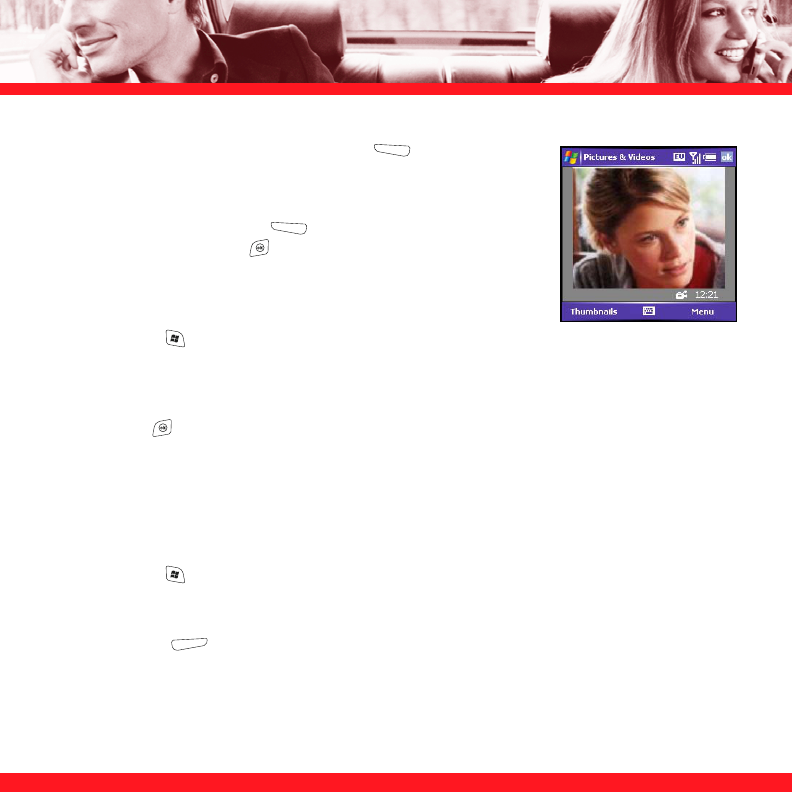
62
7. When you’re done recording, press Stop or Center to
stop recording.
8. (Optional) To review the video in Windows Media Player
Mobile, press Thumbnails , highlight the video, and then
press Center. Press OK to return to the Thumbnail View in
Pictures & Videos.
Viewing a picture or video
1. Press Start and select Pictures & Videos.
2. Select the picture or video you want to view. For more info on viewing videos, see “Playing
media files on your smartphone” on page 64.
3. Press OK to return to the Thumbnail View.
NOTE To view pictures or videos in a different folder, go the Thumbnail View, select the Show list in the upper left, and then
select the album you want to view.
Creating a video ringtone
You can save a video that you record as a ringtone.
1. Press Start and select Pictures & Videos.
2. Highlight the video you want to use as a ringtone.
3. Press Menu and select Save to Contact Ring Tone.
4. Select the contact you want to assign the ringtone to.

PLAYING MEDIA FILES
63
WINDOWS MEDIA PLAYER MOBILE
Windows Media Player Mobile can play music, audio, and video files that are stored on your
smartphone or on an expansion card (sold separately) in any of the following file formats: WMA,
WMV, MP3, and 3G2.
Transferring media files to your smartphone
Use the Sync feature in the desktop version of Windows Media Player 10 to transfer compatible
media files from your computer to an expansion card or your smartphone. Using the Sync feature
ensures that the files and album art transfer correctly.
1. On your computer, open Windows Media Player 10.
2. (Optional) Insert a 32MB or larger expansion card into your smartphone.
3. Connect your smartphone to your computer with the USB sync cable.
4. When the Device Setup Wizard opens on your computer, click Automatic.
5. Check the Customize the playlists that will be synchronized box.
6. Select the playlists you want to sync.
7. Click Finish to begin the transfer. The next time you connect your smartphone to your
computer while the desktop version of Windows Media Player 10 is running, synchronization
starts automatically.
NOTE Be patient; transferring media files can take several minutes.

64
Playing media files on your smartphone
You can listen to media files through the speaker on the back of your smartphone or through a
stereo headphone (3.5mm stereo headphone adapter or 2.5mm stereo headphone required, sold
separately).
NOTE If you can’t find a media file on your expansion card, update the library (see “Working with libraries” on page 65).
1. Press Start and select Windows Media.
2. Press Menu and select Library.
3. Do one of the following:
■To play a file from a library, select the Library list in the upper left, and then select the
library you want to use.
■To play a file that is not in a library, press Menu and select Open File.
■To play a file from the web, press Menu and select Open URL. Select URL and enter
the website address, or select History and select a site you’ve visited before.
4. Select the item you want to play, and then press Play .
5. Use any of the following hardware or onscreen controls during playback:
Center or Plays the current file.
Center or Pauses the current file.
Left or Skips to the beginning of the current file or to the previous file.
Right or Skips to the next file.
Sets the point where playback begins. Tap and drag the slider to change the position.
Volume button or Increases the volume level.
Volume button or Decreases the volume level.

PLAYING MEDIA FILES
65
Turns the sound on or off.
Displays a video using the full screen.
Displays a website where you can find music and videos to play.
Indicates the rating of the current file. Select the star to change the rating.
6. Press Menu and select any of the following during playback:
■Library: Displays the Library screen so you can select a different song to play.
■Shuffle/Repeat > Shuffle: Plays the Now Playing playlist in random order. A check appears
next to this command when it is on.
■Shuffle/Repeat > Repeat: Plays the Now Playing playlist repeatedly. A check appears next
to this command when it is on.
■Stop: Ends playback.
Working with libraries
A library represents a media storage location, so you should have two libraries: My Device and
My Storage Card. Each library contains links to the media files in that location. Windows Media
Player Mobile usually updates the My Device library automatically, but you must manually update
the My Storage Card library.
1. Press Start and select Windows Media.
2. Press Menu and select Library.
3. Press Menu and select Update Library.
4. Wait for the files to be added, and then select Done.
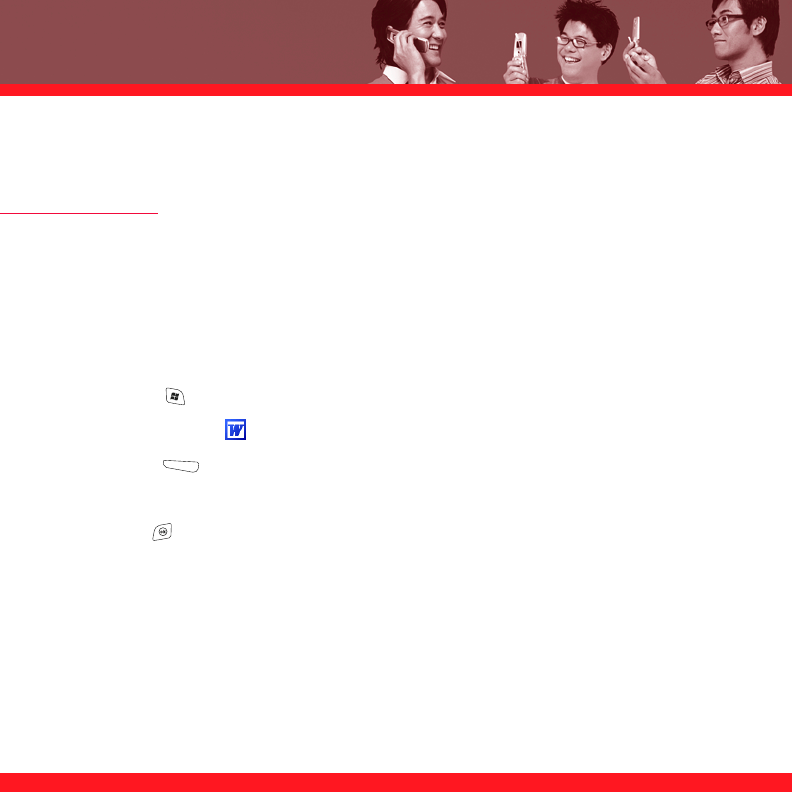
66
STAYING PRODUCTIVE
WORD MOBILE
You can create and edit documents and templates and save them as DOC, RTF, TXT, and DOT
files. You can also edit Microsoft® Office Word® documents and templates that you create on
your computer. However, keep in mind that some of the information and formatting may be lost
when you save the document on your smartphone. See your User Guide for details on supported
and unsupported features.
Creating a document
1. Press Start and select Programs.
2. Select Word Mobile .
3. Press New .
4. Enter the text of the document.
5. Press OK to save the file.

STAYING PRODUCTIVE
67
POWERPOINT MOBILE
With PowerPoint Mobile, you can open and view slide show presentations created on your
computer. Many presentation elements such as slide transitions, animations, and URL links are
also supported. See your User Guide for details on supported and unsupported features.
Playing a presentation
1. Press Start and select Programs.
2. Select PowerPoint Mobile .
3. In the presentation list, highlight the presentation you want to play.
4. Press Center.
5. Do any of the following:
■Press Right to advance to the next slide or Left to view the previous slide.
■Press Menu , select Go to Slide, and select the slide you want to view.
■Select Next or Previous to play animations.
■Press Menu , select Zoom In, and then select to zoom in or to zoom out. To
scroll within the current slide, tap and drag the slide. To return to the slide show,
select .
6. Press Menu and select End Show.

68
EXCEL MOBILE
With Excel Mobile you can create and edit workbooks and templates on your smartphone. You
can also edit workbooks and templates that you create on your computer. However, keep in mind
that you may lose some of the information and formatting when you save the workbook on your
smartphone. See your User Guide for details on supported and unsupported features.
Creating a workbook
1. Press Start and select Programs.
2. Select Excel Mobile .
3. Press New .
4. Highlight a cell where you want to enter text or other info.
5. Enter the info in the cell, and then press Enter .
6. Repeat steps 4 and 5 to enter the remaining info.
7. Press OK to save the file.
Entering a formula
1. Highlight the cell where you want to enter the formula.
2. Enter an = sign followed by any values, cell references, name references, operators, and
functions.
Example: =(B4/25)+100=Revenue-Expenses
3. Press Enter .
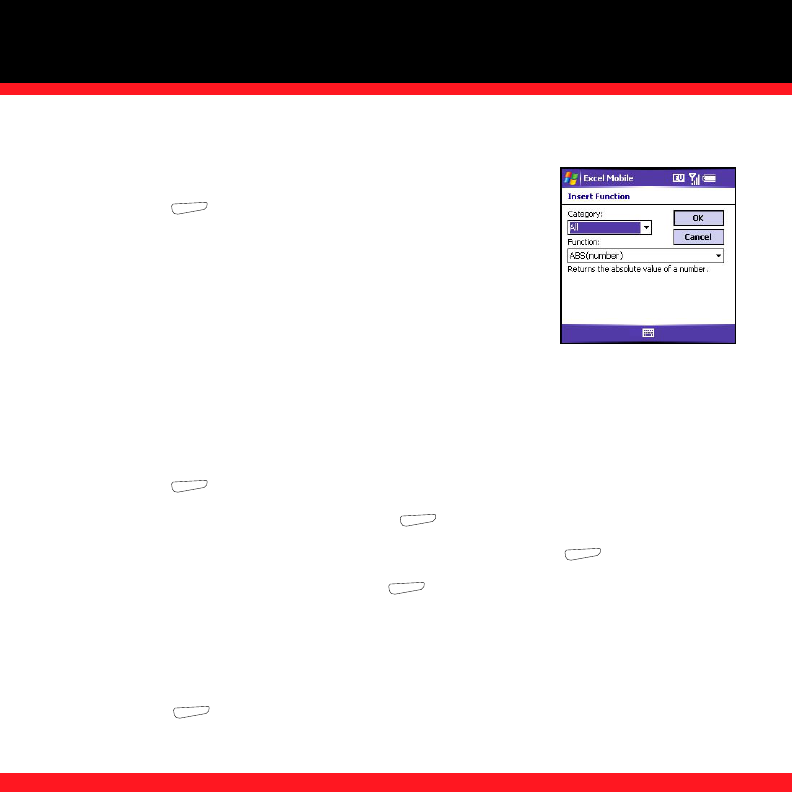
STAYING PRODUCTIVE
69
Inserting a function
1. Open the workbook where you want to insert the function.
2. Press Menu and select Insert > Function.
3. Select the Category list, and then select the type of function you
want to insert.
4. Select the Function list, and then select the specific function you
want to insert.
5. Select OK.
Creating a chart
1. Open the workbook you want to create a chart from.
2. Highlight the cells you want to include in the chart.
3. Press Menu and select Insert > Chart.
4. Select the type of chart, and then press Next .
5. Confirm the area you want the chart to include, and then press Next .
6. Select the data layout, and then press Next .
7. Check the boxes to indicate whether the first row and column represent labels.
8. Select whether you want the chart to appear as a separate worksheet within the current
workbook, or as part of the current worksheet.
9. Press Finish .
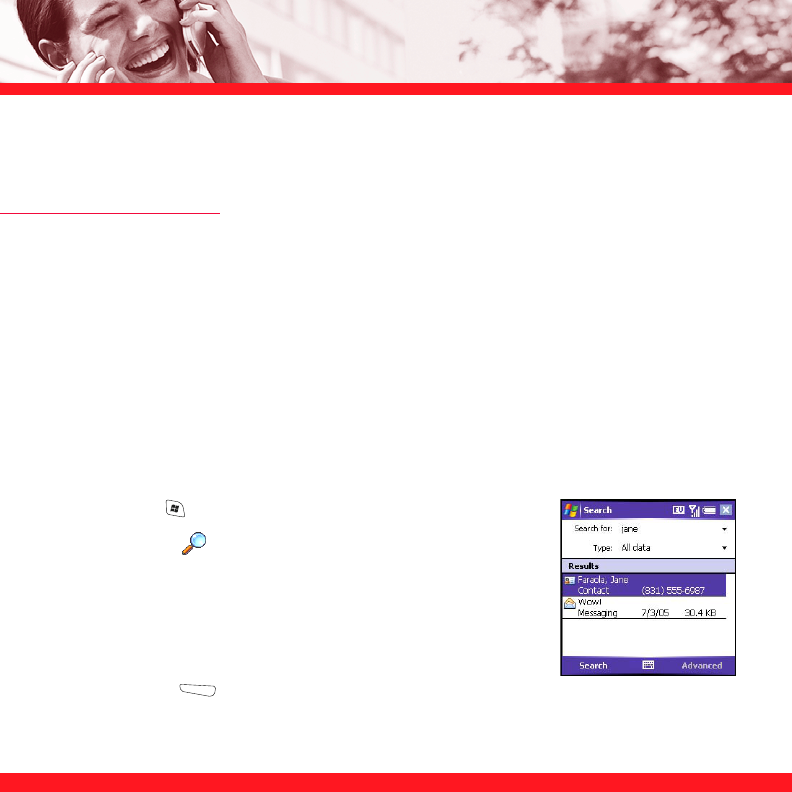
70
MANAGING FILES AND APPLICATIONS
FINDING INFORMATION
With the built-in search features on your smartphone, you can find information quickly:
■Lookup: Helps you find and dial your contacts by name or phone number. See “Dialing by
contact name” on page 23 for details.
■Search: Looks through the text in all the applications on your smartphone.
■File Explorer: Lets you browse files and folders on your smartphone or an expansion card.
Using Search
Search for files and other items stored in the My Documents folder on your smartphone or on an
expansion card. You can search by file name or by words located in the item. For example, you
can search for words within notes, appointments, contacts, and tasks.
1. Press Start and select Programs.
2. Select Search .
3. Select Search for, and then enter the file name, word, or other
info you want to find.
4. Select the Type list, and then select the kind of information you
want to find.
5. Press Search , and then use the 5-way to select and view
an item from the search results.
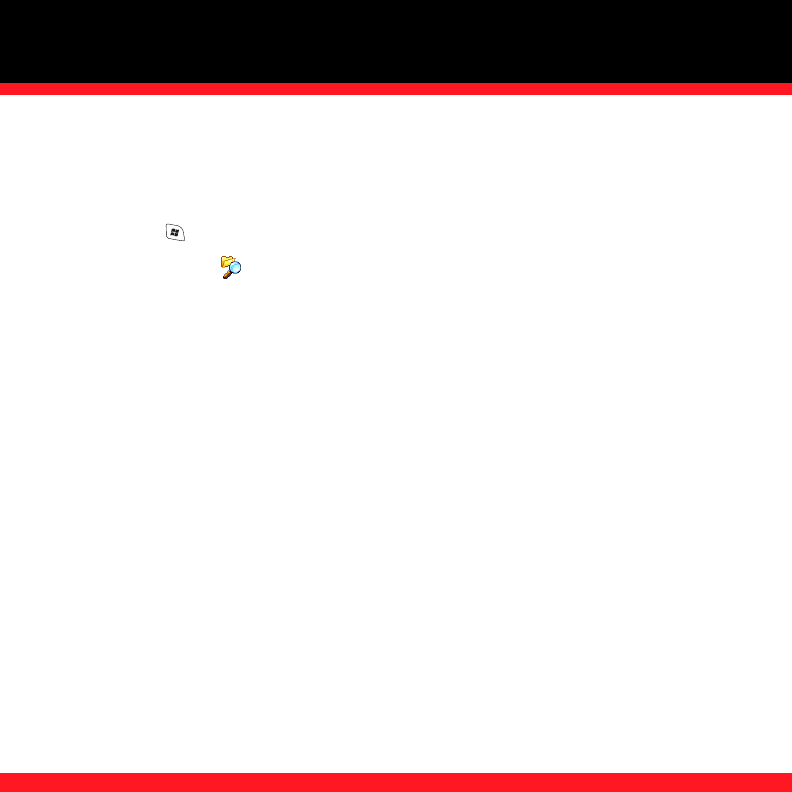
MANAGING FILES AND APPLICATIONS
71
Exploring files and folders
File Explorer lets you browse the contents of folders on your smartphone. The root folder on your
smartphone is named My Device. My Device is similar to My Computer on your computer.
1. Press Start and select Programs.
2. Select File Explorer .
3. Select the Show list in the upper left, and then select the folder you want to explore.
4. Do any of the following:
■To open an item, select it.
■To quickly delete, rename, copy, beam, or email an item, highlight the item, press and
hold Center to open the shortcut menu, and then select the appropriate command.
■To highlight multiple items, tap and drag the stylus.
[ ! ] IMPORTANT Do not delete any files that you cannot identify. These files may be required for your smartphone to
function properly.

72
INSTALLING APPLICATIONS
You can install any of the additional software included on the Windows Mobile Getting Started
Disc as well as other third-party applications that are compatible with Windows Mobile 5.0
devices. To learn more, go to www.palm.com/mytreo700wVerizon.
NOTE Be sure to select and install Microsoft Windows Mobile 5.0 software for Pocket PC Phone Edition. Microsoft
Windows Mobile 5.0 software for Smartphone is not compatible with your Treo™ smartphone. If an application does not have
a Microsoft Mobile to Market certificate, you will see a message indicating that the application is untrusted. If this occurs, you
can indicate whether you want to continue the installation.
Installing applications from the Internet
You can use Internet Explorer Mobile to install Windows Mobile apps in the CAB file format
directly from the Internet. You must use your computer to install apps in other file formats.
1. Make sure your phone is on (see “Turning your phone on and off” on page 3).
2. Press Start and select Internet Explorer.
3. Go to the page that contains the link to the application you want to download.
4. Press Left or Right to highlight the link to the file, and then press Center to start the
download process.
5. Press Start and select Programs.
6. Select File Explorer .
7. Go to the My Documents folder in File Explorer.
8. Tap the file you downloaded to start the installation program.
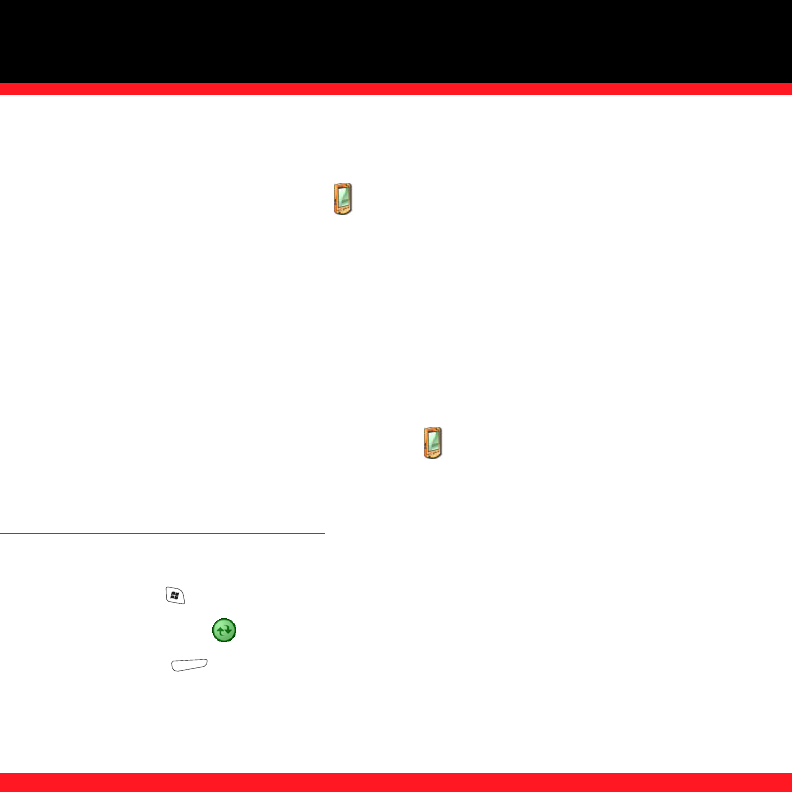
MANAGING FILES AND APPLICATIONS
73
Installing applications from your computer
1. Open My Computer or Windows Explorer on your computer.
2. Copy the application file(s) into the Mobile Device folder.
3. Connect your smartphone to your computer to synchronize and install the application(s) on
your smartphone.
Installing applications onto an expansion card
1. Insert the expansion card into the expansion card slot (see “Removing and inserting
expansion cards” on page 77).
2. Open the ActiveSync® window on your computer.
3. Click Tools and select Explore Device.
4. Double-click My Windows Mobile-Based Device to open the Mobile Device folder.
5. Copy the application file(s) into the Storage Card folder inside the Mobile Device folder.
SETTING SYNCHRONIZATION OPTIONS
Selecting which info to sync
1. Press Start and select Programs.
2. Select ActiveSync .
3. Press Menu and select Options.
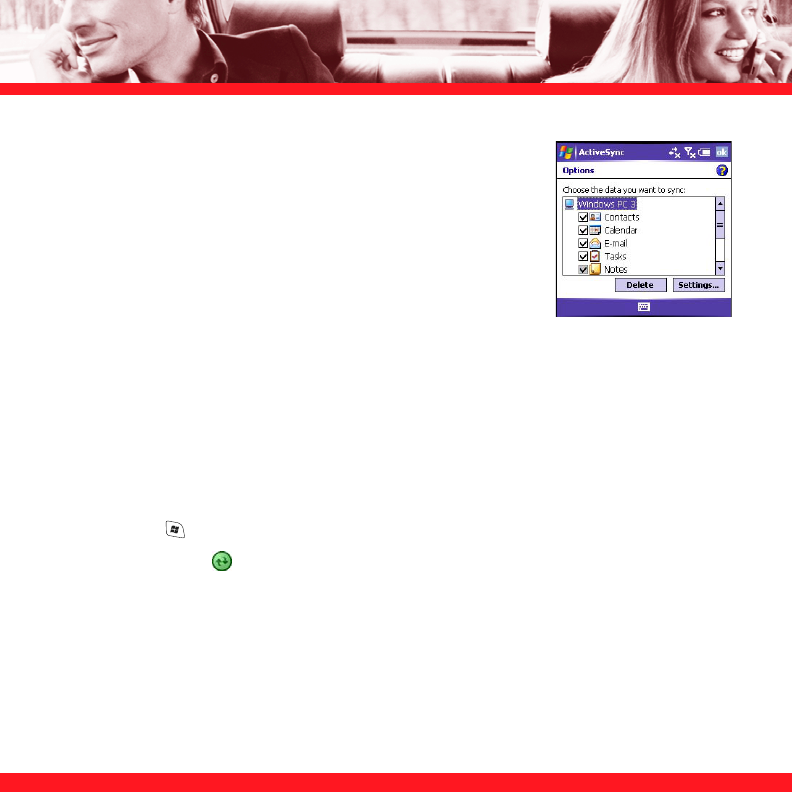
74
4. Do any of the following:
■Check the box next to any items you want to synchronize. If
you cannot check a box, you might have to uncheck a box
for the same information type elsewhere in the list.
■Uncheck the box next to any items you want to stop
synchronizing.
■Select an item and then select Settings to customize the
settings for that item. Settings are not available for all items.
Starting and stopping synchronization
If ActiveSync is running on your computer and you connect your smartphone to your computer,
synchronization begins automatically. If you ever need to manually start or stop synchronization,
follow these steps:
1. Connect your smartphone to your computer (see the setup poster for details). If you are only
synchronizing wirelessly with Exchange Server, you do not have to connect the device.
2. Press Start and select Programs.
3. Select ActiveSync .
NOTE To end synchronization before it completes, select Stop.
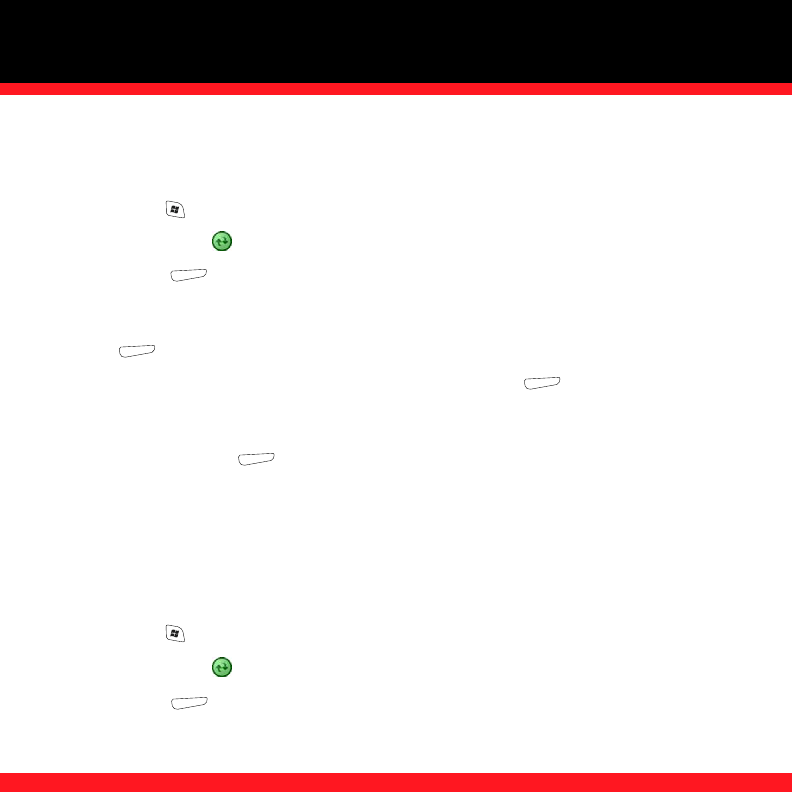
MANAGING FILES AND APPLICATIONS
75
Synchronizing with Exchange Server
You can sync with Exchange Server using a connection to a wireless network or a computer.
1. Press Start and select Programs.
2. Select ActiveSync .
3. Press Menu and select Configure Server. If you have not yet set up sync with Exchange
Server, this says Add Server Source.
4. Select Server address, enter the name of the server running Exchange Server, and then press
Next .
5. Enter your name, password, and domain, and then press Next . To change the rules for
resolving synchronization conflicts, select Advanced.
6. Check the boxes next to the type of info that you want to synchronize with Exchange Server,
and then press Finish .
Setting the synchronization schedule
You can schedule wireless synchronization to occur automatically at regular intervals. If you
prefer to synchronize manually, do not turn on these settings.
1. Connect your smartphone to your computer (see the setup poster). If you are only
synchronizing wirelessly with Exchange Server, you do not have to connect the device.
2. Press Start and select Programs.
3. Select ActiveSync .
4. Press Menu and select Schedule.

76
5. Set any of the following options:
■Peak times: Sets the frequency for high-traffic time periods such as when you are at work
or when email volume is high.
■Off-peak times: Sets the frequency for low-traffic time periods such as late at night.
■Use above settings while roaming: Sets the frequency while you are roaming outside the
Verizon Wireless network. To minimize roaming charges, uncheck this box and
synchronize manually while roaming.
■Send outgoing items immediately: Sets whether items are sent as soon as you select Send
in the Messaging application, or whether they are held until the next synchronization.
6. Press OK .
NOTE Decreasing the frequency settings conserves battery power.
USING EXPANSION CARDS
The expansion card slot on your smartphone lets you add SD cards and MultiMediaCard cards to
extend the storage capacity of your smartphone. For example, expansion cards can store pictures
and videos, MP3 audio files, email attachments, games, and much more. Your smartphone is
also compatible with most SDIO cards—which let you add accessories, such as a Wi-Fi® network
card, to your smartphone. Expansion cards are sold separately.
NOTE See “Regulatory Information” in the User Guide for guidance in using a Wi-Fi card with your Treo 700w smartphone.
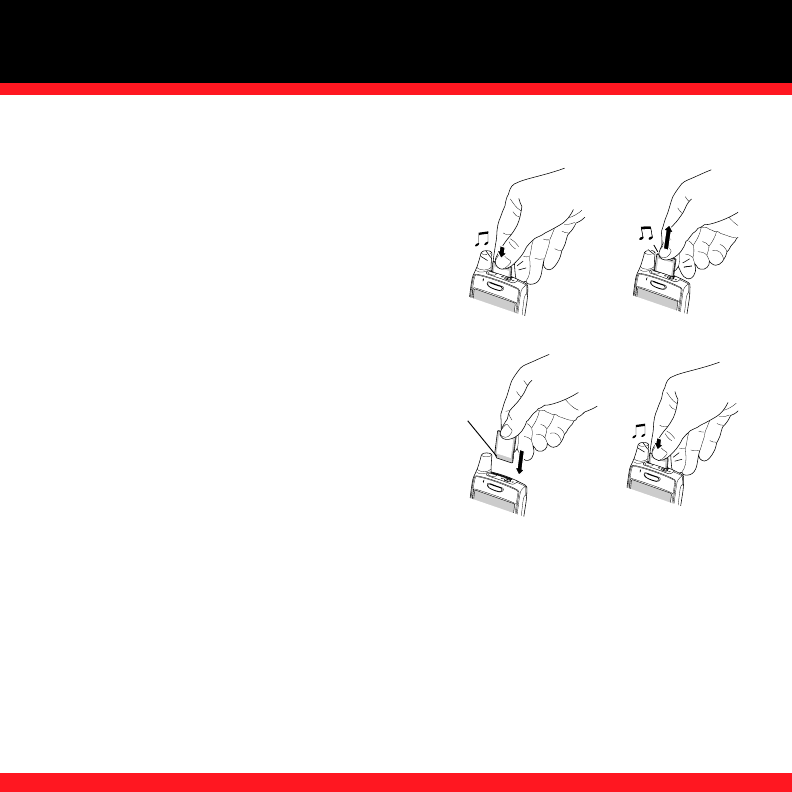
MANAGING FILES AND APPLICATIONS
77
Removing and inserting expansion cards
Your smartphone comes with a dummy card inside
the expansion card slot. When you do not have a
functioning card inside the slot, reinsert the dummy
card to protect the slot opening.
1. Press down and release the dummy card.
2. After you feel the dummy card eject from the slot,
remove the card from the slot.
3. To insert an expansion card, hold your
smartphone with the screen facing you and the
card with the label facing you. The notch on the
card should be in the lower corner by the antenna.
4. Insert the card into the expansion card slot until
you feel it lock into place and hear the
confirmation tone.
Notch
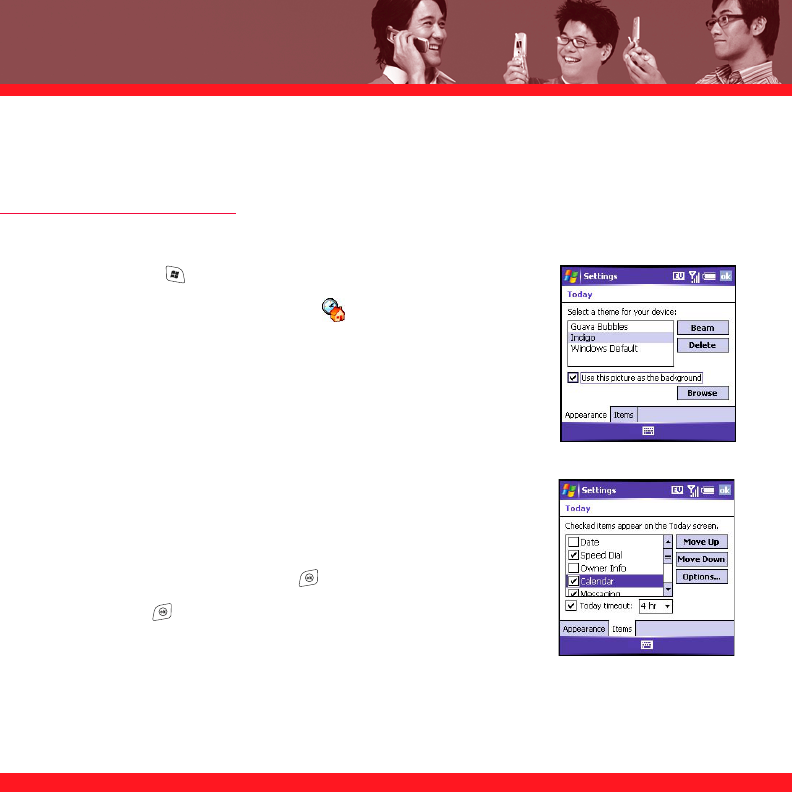
78
CUSTOMIZING YOUR SMARTPHONE
TODAY SCREEN SETTINGS
Selecting your Today screen background
1. Press Start and select Settings.
2. On the Personal tab, select Today .
3. On the Appearance tab, check the Use this picture as the
background box.
4. Select Browse.
5. Select the picture you want for your Today screen background.
6. Select the Items tab.
7. Check the boxes next to the items you want to appear on your
Today screen and uncheck any items that you want to hide.
8. (Optional) Select Options (if available) to configure the settings
for the current item. Press OK to return to Today Settings.
9. Press OK .
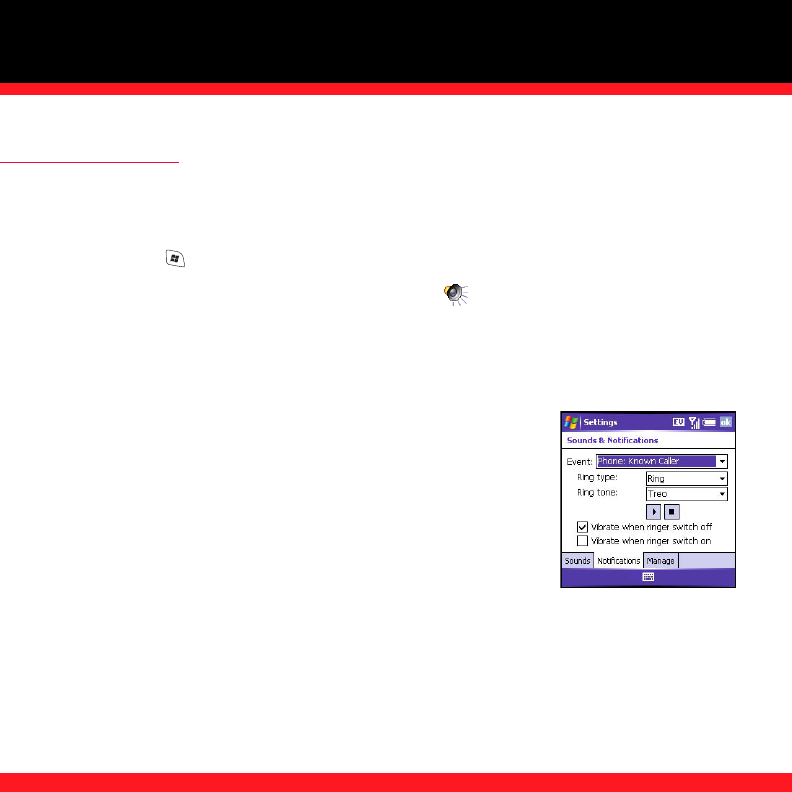
CUSTOMIZING YOUR SMARTPHONE
79
SOUND SETTINGS
Setting ringtones
You can set different tones for different types of incoming phone calls and notifications.
1. Press Start and select Settings.
2. On the Personal tab, select Sounds & Notifications .
3. Select the Notifications tab.
4. Select the Event list, and then select which type of call or notification you want to set the
ringtone for:
■Phone: Known Caller: An incoming call from someone in your
Contacts list or Speed Dial list.
■Phone: Missed call: A call you did not answer.
■Phone: Roaming: A call that comes in when you’re outside
your home mobile network.
■Phone: Unknown Caller: An incoming call from someone
identified by caller ID who is not in your Contacts list or Speed
Dial list.
■Phone: Voice mail: A new voicemail.
5. Select the Ring type list, and then select the ring style for the selected type of call.
6. Select the Ring tone list, and then select the sound for the selected type of call.
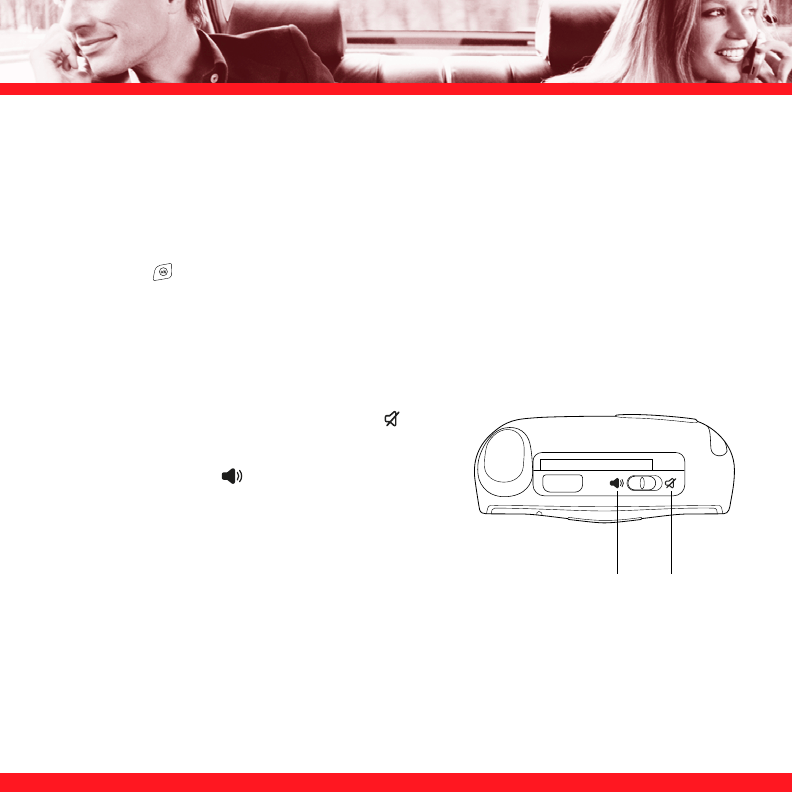
80
7. Check the Vibrate when… boxes to turn the vibrate feature on/off based on the ringer switch
setting.
8. (Optional) Select Play to preview the sound.
9. Repeat steps 4–7 to select ringtones for other types of calls.
10. Press OK .
Setting the ringer switch
In certain situations, such as meetings and theaters, you need to turn off all sounds on your
smartphone. You can silence all sounds on your smartphone, including smartphone ringtones,
Calendar notifications, and system sounds. This does not mute the speaker during phone calls.
1. Slide the ringer switch to Sound Mode Off .
2. To hear all sounds again, slide the ringer switch
to Sound Mode On .
When you slide the ringer switch back to the Sound
Mode On position, it restores the previous sound
settings. For example, if the smartphone ring volume
is set to the loudest setting and you slide the ringer
switch to Sound Mode Off, you do not hear the
smartphone ring. When you move the ringer switch
back to Sound Mode On, the smartphone ring volume
is still set to the loudest setting.
Sound
Mode On
Sound
Mode Off
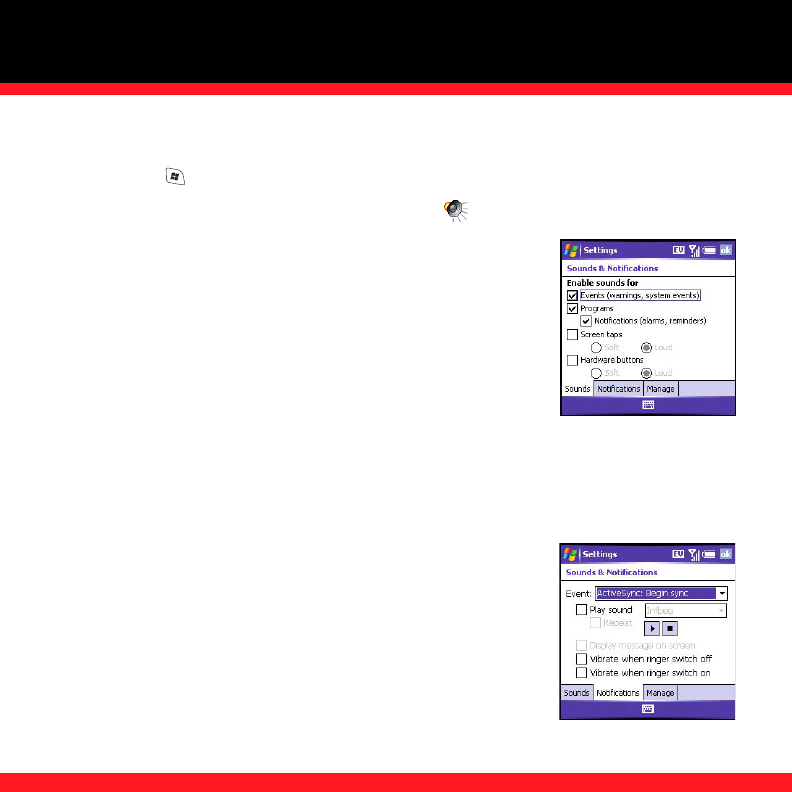
CUSTOMIZING YOUR SMARTPHONE
81
Selecting Sounds & Notifications
1. Press Start and select Settings.
2. On the Personal tab, select Sounds & Notifications .
3. On the Sounds tab, set any of the following options:
■Events: Turns sounds on/off for system warnings and error
messages.
■Programs: Turns sounds on/off in the applications on your
smartphone.
■Notifications: Turns alarms and reminders on/off in the
applications on your smartphone.
■Screen taps: Turns sounds associated with tapping the screen on/off, and sets the volume
level when this sound is turned on.
■Hardware buttons: Turns sounds associated with pressing buttons on/off, and sets the
volume level when this sound is turned on.
4. Select the Notifications tab and set any of the following options:
■Event: Specifies which action you want to change the settings
for. The remaining options vary based on the action selection.
■Play sound: Lets you turn the sound on/off for the selected
event. To select a different sound select the list to the right of
this setting, and then select a different sound. To preview the
sound, select Play Sound, and then select Play.

82
■Repeat: Indicates whether the sound plays more than once, if turned on.
■Display message on screen: Indicates whether a notification message appears onscreen
for the selected event.
■Vibrate: Indicates whether your smartphone vibrates to notify you about the selected
event.
5. Press OK .
DISPLAY AND APPEARANCE SETTINGS
Adjusting the brightness
1. Press Option , and then press .
2. Press Left and Right to adjust the brightness.
3. Press OK .
Changing the text size
1. Press Start and select Settings.
2. Select the System tab, and then select Screen .
3. Select the Text Size tab.
4. Press Left and Right to adjust the text size.
5. Press OK .
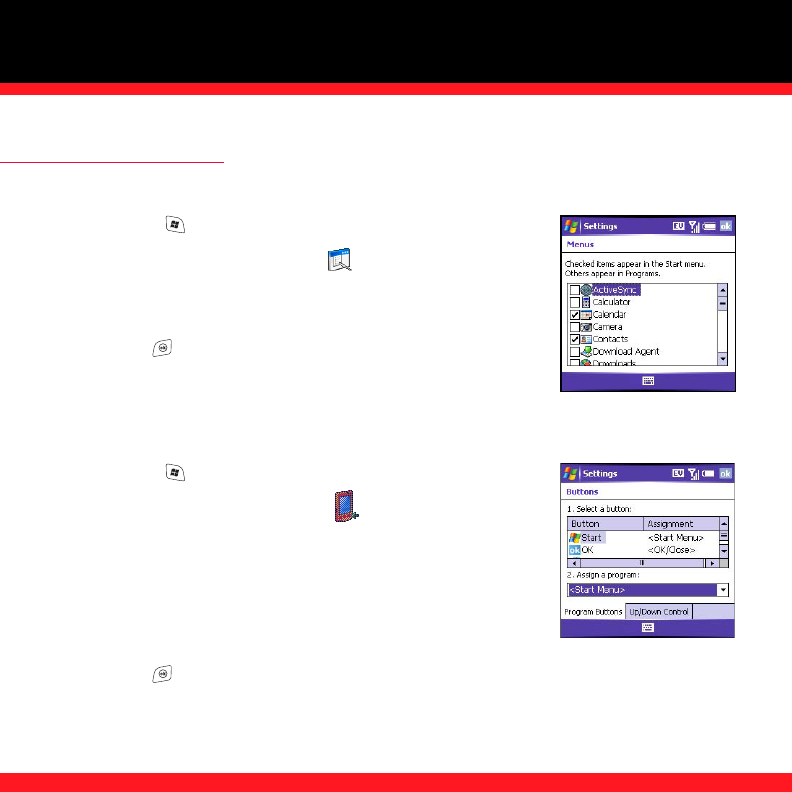
CUSTOMIZING YOUR SMARTPHONE
83
APPLICATION SETTINGS
Arranging the Start menu
1. Press Start and select Settings.
2. On the Personal tab, select Menus .
3. Check the boxes next to the applications you want to see in the
Start menu.
4. Press OK .
Reassigning buttons
Buttons Settings lets you select which applications are associated
with many of the buttons and key combinations on your smartphone.
1. Press Start and select Settings.
2. On the Personal tab, select Buttons .
3. On the Program Buttons tab, highlight the button or key
combination you want to change in the Buttons list.
4. Select the Assign a program list, and then select the application
you want to assign to the button or key combination you selected
in step 3.
5. Press OK .

84
LOCKING YOUR SMARTPHONE AND INFO
Your smartphone includes several features that help you protect your smartphone from
inadvertent use and keep your information private. The built-in security software lets you use
your smartphone for emergency calls, such as dialing 911, even if it is locked.
■Keyguard: Manually disables all buttons and the screen’s touch-sensitive feature to prevent
accidental presses in your briefcase or pocket.
■Auto-Keyguard and touchscreen lockout: Automatically enables Keyguard after a period of
inactivity and lets you disable the screen’s touch-sensitive feature during an active call.
■Phone Lock: Requires a lock code to make calls. See the User Guide for details.
■System password lock: Requires a password to see any information on your smartphone.
Using Keyguard
By default, your keyboard locks so that you don’t accidentally press buttons or activate screen
items while your smartphone is in a pocket or bag.
■To turn off Keyguard, press Center.
■To manually turn on Keyguard when your smartphone screen is on, press Option and
Power/End .
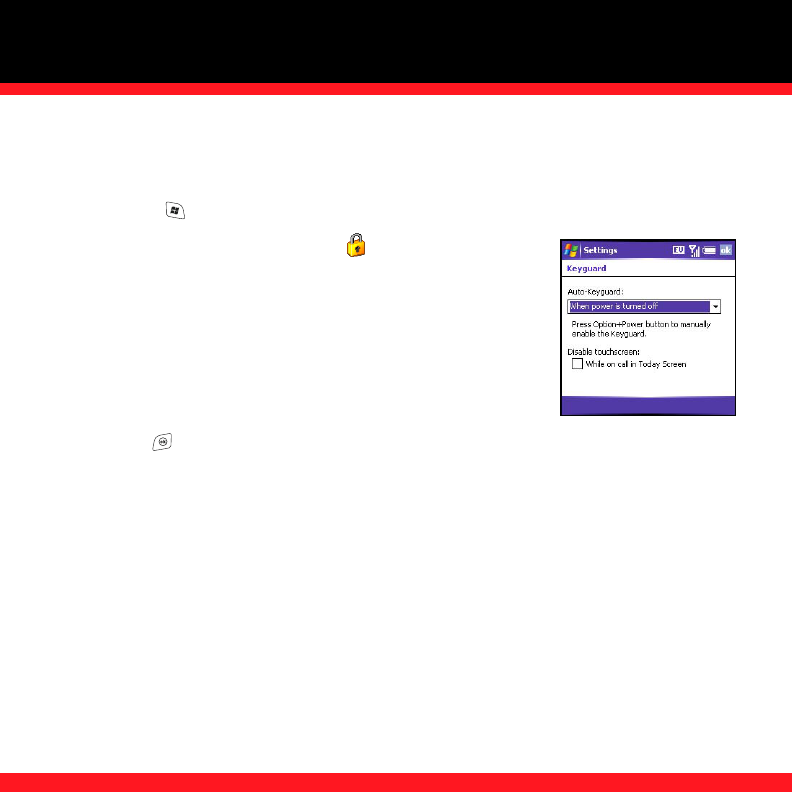
CUSTOMIZING YOUR SMARTPHONE
85
Using Auto-Keyguard and touchscreen lockout
Auto-Keyguard lets you automatically lock the keyboard after a period of inactivity.
1. Press Start and select Settings.
2. On the Personal tab, select Keyguard .
3. Set any of the following options:
■Auto-Keyguard: Sets the period of inactivity that passes before
the keyboard automatically locks, or disables the auto-
keyguard feature.
■Disable touchscreen: Indicates whether the screen’s touch-
sensitive feature is enabled during a call.
4. Press OK .
NOTE If you’re using a headset or hands-free device and your smartphone is in a pocket or bag, you can manually turn on
Keyguard during a call to prevent accidental key presses. Press Option and Power/End to manually turn on Keyguard.
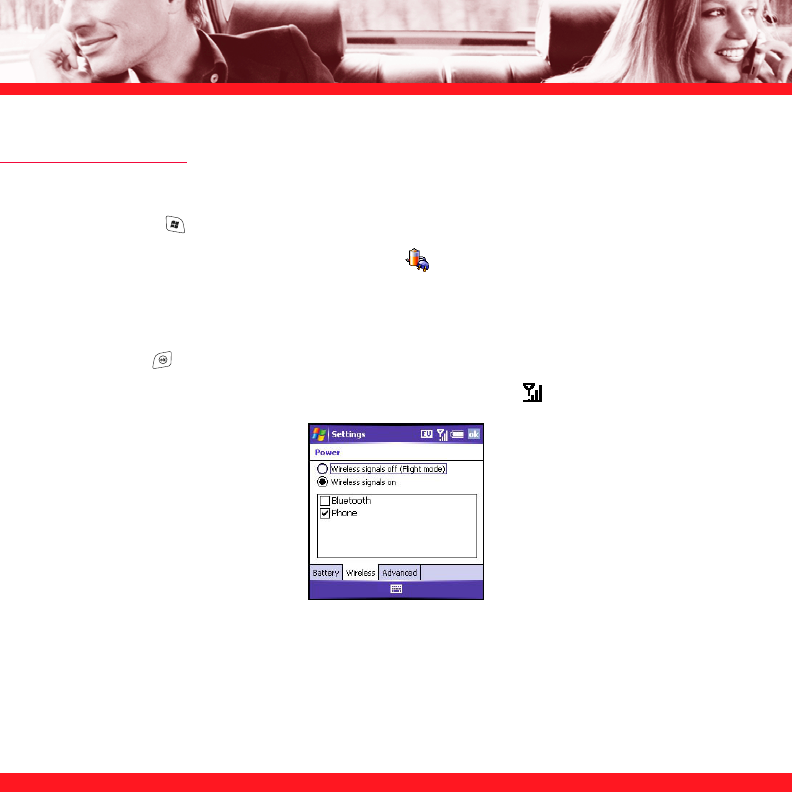
86
SYSTEM SETTINGS
Turning Wireless Services On/Off
1. Press Start and select Settings.
2. Select the System tab, and then select Power .
3. Select the Wireless tab and turn your smartphone’s wireless features on/off.
4. Select the wireless signals you want to control when you turn Flight Mode on and off.
5. Press OK to finish.
NOTE You can also turn Flight Mode on and off by tapping the signal-strength icon at the top of the screen.
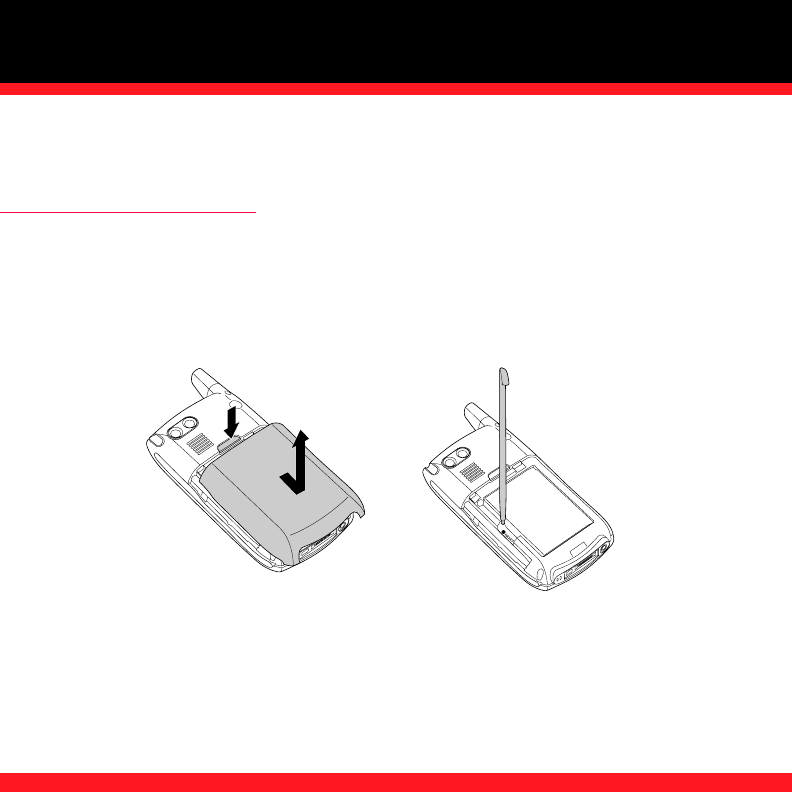
GETTING HELP
87
GETTING HELP
PERFORMING A SOFT RESET
A soft reset is similar to restarting a computer. If your smartphone is not responding or you have
trouble synchronizing with your computer, a soft reset may help.
1. Use one hand to press the battery door release and use the other hand to slide the battery
door downward to remove it from your smartphone.
2. Use the stylus tip to gently press the reset button on the back of your smartphone.
3. Wait for the progress bar on the Treo™ smartphone logo screen to fill before continuing to
use your smartphone.
NOTE If the phone and Bluetooth signals were on before a reset, these signals automatically turn on after the reset.

88
WHERE TO LEARN MORE
For a quick introduction
■Quick Tour: The Quick Tour highlights many of your smartphone’s features. It is already
installed on your smartphone, and you can open it at any time. Press Start , select
Programs, and then select Quick Tour .
■Interactive User Guide: An interactive introduction to your smartphone. To access the
Interactive User Guide, insert the Welcome CD into your computer’s CD drive.
While using your smartphone
■Help: Many of the built-in applications include on-device Help, so that you can learn about the
tasks you can perform in that application. To access Help, go to the application or screen you
want help with, press Start , and select Help.
■User Guide: A complete guide to your smartphone’s features with detailed step-by-step
instructions, tips, and troubleshooting info. To access the User Guide on your desktop
computer, click Start > All Programs > Palm > Treo 700w User Guide, or go to:
www.palm.com/Treo700wVerizon-UserGuide.
■Online support from Palm: For up-to-date downloads, troubleshooting, and support
information, check out www.palm.com/us/support/us/support/Treo700wVerizon.

GETTING HELP
89
If you need more information
■Books: Many books on Windows Mobile devices are available in local or online book retailers
(look in the computers section), or visit www.palm.com/mytreo700wVerizon.
■Online forums: Consult online Treo™ smartphone user discussion groups to swap
information and learn about topics you may find nowhere else. Visit
www.palm.com/us/support/us/support/Treo700wVerizon for details.
■Verizon Wireless Customer Care: For questions about your mobile account or features
available on the network, contact Verizon Wireless Customer Care or visit
www.verizonwireless.com for the latest information and help.

90

REGULATORY INFORMATION
91
REGULATORY INFORMATION
FCC Statement This equipment has been tested and found
to comply with the limits for a Class B computer peripheral,
pursuant to part 15 of the FCC Rules. These limits are
designed to provide reasonable protection against harmful
interference in a residential installation. This equipment
generates, uses and can radiate radio frequency energy
and, if not installed and used in accordance with the
instructions, may cause harmful interference to radio
communications. However, there is no guarantee that
interference will not occur in a particular installation. If this
equipment does cause harmful interference to radio or
television reception, which can be determined by turning
the equipment off and on, the user is encouraged to try to
correct the interference by one or more of the following
measures:
■Reorient or relocate the receiving antenna.
■Increase the separation between the equipment and
receiver.
■Connect the equipment into an outlet on a circuit
different from that to which the receiver is connected.
■Consult the dealer or an experienced radio/TV
technician for help.
This device complies with part 15 of the FCC Rules.
Operation is subject to the following two conditions: (1)
This device may not cause harmful interference, and (2)
this device must accept any interference received,
including interference that may cause undesired operation.
RF Safety Exposure To Radio Frequency Energy (SAR)
Radio transmitting devices radiate Radio Frequency (RF)
energy during its operation. RF energy can be absorbed
into the human body and potentially can cause adverse
health effects if excessive levels are absorbed. The unit of
measurement for human exposure to RF energy is
“Specific Absorption Rate” (SAR).
The Federal Communications Commission (FCC), Industrie
Canada (IC), and other agencies around the world have
established limits that incorporate a substantial safety
margin designed to assure the safety of all persons using
this equipment.
In order to certify this unit for sale in the US, Canada and
Europe this unit has been tested for RF exposure
compliance at a qualified test laboratory and found to
comply with the regulations regarding exposure to RF
Energy.
SAR was measured with the unit transmitting at its
maximum certified RF power. Often, however, during
normal operation the unit will transmit much less than
maximum power. Transmit power is controlled
automatically and, in general is reduced as you get closer
to a cellular base station. This reduction in transmit power
will result in a lower RF energy exposure and resulting SAR
value.
FCC RF Safety Statement In order to comply with FCC RF
exposure safety guidelines, users MUST use one of the
following types of bodyworn accessories.
1. A Palm® brand body-worn accessory that has been
tested for SAR compliance and is intended for use
with this product.
2. An accessory that contains NO metal (snaps, clips,
etc.) and provides AT LEAST 1.5 cm of separation
between the users body and the unit.

92
Do NOT use the device in a manner such that it is in direct
contact with the body (e.g., on the lap or in a breast
pocket). Such use will likely exceed FCC RF safety
exposure limits See www.fcc.gov/oet/rfsafety/ for more
information on RF exposure safety.
The Palm® Treo™ 700w smartphone may be used with a
Wi-Fi® SDIO card; however, the user must ensure that the
SDIO Wi-Fi card has been approved by the FCC for use with
the Treo 700w smartphone. For a list of SDIO Wi-Fi cards
approved by the FCC for use with the Treo 700w
smartphone, please go to www.palm.com/us/support/
Treo700wVerizon.
If using a SDIO Wi-Fi card not approved for use with the
Treo 700w smartphone by the FCC, the user must turn off
the phone (CDMA radio) on the Treo 700w smartphone.
Use of an SDIO wireless transmitter that is not approved in
conjunction with the phone (CDMA radio) is not authorized
by the FCC and may exceed FCC RF exposure guidelines.
Responsible party:
(North America) (Europe)
Palm, Inc. Bornibus Francois
950 W. Maude Ave. Buckhurst Court
Sunnyvale, CA 94085 London Road
USA Wokingham, Berkshire
www.palm.com/us/support RG40 1PA, UK
Antenna Care/Unauthorized Modifications Use only the
supplied integral antenna. Unauthorized antenna
modifications or attachments could damage the unit and
may violate FCC regulations. Any changes or modifications
not expressly approved by the party responsible for
compliance could void the user’s authority to operate the
equipment.
Potentially Unsafe Areas Potentially explosive
atmospheres: Turn off your smartphone when you are in
any areas with a potentially explosive atmosphere, such as
fueling areas (gas or petrol stations) or storage facilities
for fuel or chemicals.
Declaration of Conformity
Treo 700w Model
Palm declares that the above model of Treo smartphone is
compliant with the regulations below. The declaration
applies to the smartphone and its associated accessories
(power supply, headset, and USB cable) where applicable.
For SAR values when used with a SDIO Wi-Fi card go to:
www.palm.com/us/support/Treo700wVerizon.
FCC OET Bulletin
65 Supplement C
Safety: EN 60950:
2000 (Jan-2000)
Radiated
Emissions: EN
55022
FCC ID: O8FJIMI
IC ID: 3905A-JIMI
Maximum Scaled SAR Values (W/kg)
Band Cellular PCS
Head SAR
(Held to ear) (W/Kg)
1.26 (W/Kg)
1.26
Body SAR
(Worn) (W/Kg)
1.01 (W/Kg)
.548

REGULATORY INFORMATION
93
Using TTY
A TTY (also known as TDD or text telephone) is a
telecommunications device that allows people who are deaf
or hard of hearing, or who have speech or language
disabilities, to communicate by telephone.
Your Treo 700w smartphone is compatible with select TTY
devices. You can connect a TTY/TDD machine to your
smartphone through the headset jack, but you cannot use
your headset jack with a headset or hands-free kit while
this mode is enabled. Please check with the manufacturer
of your TTY device for connectivity information and to
ensure that the TTY device supports digital wireless
transmission.
To use TTY, you may need to make additional
arrangements with Verizon Wireless. Please contact
Verizon Wireless’s customer service department for more
information.
1. Press the Start button and select Settings.
2. Select Personal, and then select Phone.
3. Select Phone.
4. Select the TTY/TDD list, and then select either Default
mode, VCO mode, or HCO mode.
5. Press OK. A keyboard icon appears at the top of your
Today screen whenever TTY is enabled.
To disable TTY, repeat steps 1 and 2.
Hearing Aid Compatibility Compliance Hearing aid
compatibility ratings now appear on some handset
packages. If your handset has a hearing aid compatibility
rating of M3 or M4, then that handset has met or
surpassed the American National Standards Institute’s
(“ANSI”) hearing aid compatibility standard as adopted by
the Federal Communications Commission.
The handset’s M-rating along with a hearing aid’s M-rating
will assist customers in finding a handset that will work
best for them.

94
Copyright
© 2005 Palm, Inc. All rights reserved. Palm, Treo, and the
Palm and Treo logos are among the trademarks or
registered trademarks owned by or licensed to Palm, Inc. A
portion of this software includes software modules
developed by the Independent JPEG group. MPEG Layer-3
audio decoding technology is licensed from Fraunhofer IIS
and Thomson. Palm, Inc. is an authorized licensee of the
MultiMediaCard trademark. All other brand and product
names are or may be trademarks of, and are used to
identify products or services of, their respective owners.
Disclaimer and limitation of liability
Palm, Inc. and its suppliers assume no responsibility for
any damage or loss resulting from the use of this guide.
Palm, Inc. and its suppliers assume no responsibility for
any loss or claims by third parties that may arise through
the use of this software. Palm, Inc. and its suppliers
assume no responsibility for any damage or loss caused by
deletion of data as a result of malfunction, dead battery, or
repairs. Be sure to make backup copies of all important
data on other media to protect against data loss.
P/N:406-10492-00